Kyocera K60-E2-5G5 Dual Band 1xRTT CDMA Phone W/ 1xEVDO and Bluetooth User Manual
Kyocera Communications, Inc Dual Band 1xRTT CDMA Phone W/ 1xEVDO and Bluetooth
Kyocera >
User Manual
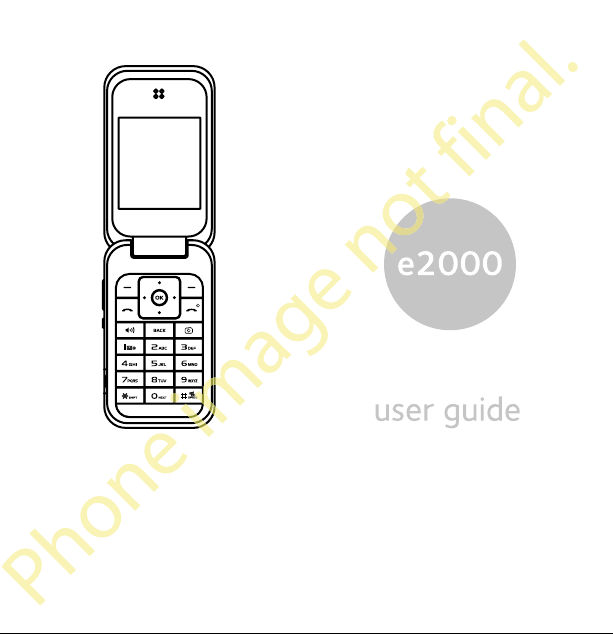
User Guide i
E2000
Generic
82-G1887-1EN, Draft 0.7
SW Version: WF0.3.10
PRL Version: 0
Factory Config: E2000_KWCGEN_WF_T10.wpd

ii
E2000 User Guide
This manual is based on the production version of
the Kyocera E2000 phone. Software changes may
have occurred after this printing. Kyocera reserves
the right to make changes in technical and product
specifications without prior notice. The products
and equipment described in this documentation are
manufactured under license from QUALCOMM
Incorporated under one or more of the following
U.S. patents:
4,901,307 5,109,390 5,267,262 5,416,797 5,506,865
5,544,196 5,657,420 5,101,501 5,267,261 5,414,796
5,504,773 5,535,239 5,600,754 5,778,338 5,228,054
5,337,338 5,710,784 5,056,109 5,568,483 5,659,569
5,490,165 5,511,073
The Kyocera Wireless Corp. (“KWC”) products
described in this manual may include copyrighted
KWC and third party software stored in
semiconductor memories or other media. Laws in
the United States and other countries preserve for
KWC and third party software providers certain
exclusive rights for copyrighted software, such as
the exclusive rights to distribute or reproduce the
copyrighted software. Accordingly, any copyrighted
software contained in the KWC products may not
be modified, reverse engineered, distributed or
reproduced in any manner not permitted by law.
Furthermore, the purchase of the KWC products
shall not be deemed to grant—either directly or by
implication, estoppel, or otherwise—any license
under the copyrights, patents, or patent
applications of KWC or any third party software
provider, except for the normal, non-exclusive
royalty-free license to use that arises by operation
of law in the sale of a product.
Kyocera is a registered trademark of Kyocera
Corporation. Brick Attack and Race 21 are
trademarks of Kyocera Wireless Corp.
QUALCOMM is a registered trademark of
QUALCOMM Incorporated.
Openwave is a trademark of Openwave Systems
Incorporated. eZiText is a registered trademark of
Zi Corporation. TransFlash is a trademark of
SanDisk Corporation. Bluetooth trademarks are
owned by Bluetooth SIG, Inc. and used by Kyocera
Wireless Corp. under license.
All other trademarks are the property of their
respective owners.
Copyright © 2007 Kyocera Wireless Corp. All rights
reserved.
Ringer Tones Copyright © 2000-2007 Kyocera
Wireless Corp.
Bluetooth® Certification
For information about E2000 Bluetooth
Certification, visit the Bluetooth Qualification
Program Web site at qualweb.bluetooth.org.
82-G1887-1EN, Rev. Draft 0.7
FCC Notice
This device complies with part 15 of the FCC rules.
Operation is subject to the following two conditions:
(1) This device may not cause harmful interference,
and (2) this device must accept any interference
received, including interference that may cause
undesired operation. To maintain compliance with
FCC RF exposure guidelines, if you wear a handset
on your body, use the Kyocera Wireless Corp.
(KWC) supplied and approved CV90-R2103-01
case, CV90-R2104-01 case or CV90-R2091-01
holster.
Other accessories used with this device for body-
worn operations must not contain any metallic
components and must provide at least 22.5 mm
separation distance including the antenna and the
user’s body.
THIS MODEL PHONE MEETS THE
GOVERNMENT’S REQUIREMENTS FOR
EXPOSURE TO RADIO WAVES.
Your wireless phone is a radio transmitter and
receiver. It is designed and manufactured to not
exceed the emission limits for exposure to radio

User Guide iii
frequency (RF) energy set by the Federal
Communications Commission of the U.S.
Government. These limits are part of
comprehensive guidelines and establish permitted
levels of RF energy for the general population. The
guidelines are based on standards that were
developed by independent scientific organizations
through periodic and thorough evaluation of
scientific studies. The standards include a
substantial safety margin designed to assure the
safety of all persons, regardless of age and health.
The exposure standard for wireless mobile phones
employs a unit of measurement known as the
Specific Absorption Rate, or SAR. The SAR limit set
by the FCC is 1.6 W/kg.*
Tests for SAR are conducted using standard
operating positions specified by the FCC with the
phone transmitting at its highest certified power
level in all tested frequency bands.
Although the SAR is determined at the highest
certified power level, the actual SAR level of the
phone while operating can be well below the
maximum value. This is because the phone is
designed to operate at multiple power levels so as
to use only the power required to reach the network.
In general, the closer you are to a wireless base
station antenna, the lower the power output.
Before a phone model is available for sale to the
public, it must be tested and certified by the FCC
that it does not exceed the limit established by the
government-adopted requirement for safe
exposure. The tests are performed in positions and
locations (e.g., at the ear and worn on the body) as
required by the FCC for each model.
Body-worn measurements differ among phone
models, depending upon availability of accessories
and FCC requirements. While there may be
differences between the SAR levels of various
phones and at various positions, they all meet the
government requirement for safe exposure.
The FCC has granted an Equipment Authorization
for this model phone with all reported SAR levels
evaluated as in compliance with the FCC RF
emission guidelines. SAR information on this model
phone is on file with the FCC and can be found
under the Display Grant section www.fcc.gov/oet/
ea after searching on the FCC ID: OVFK60-E2-
5G5.
Additional information on SAR can be found on the
Cellular Telecommunications and Internet
Association (CTIA) web-site at www.wow-
com.com.
* In the United States and Canada, the SAR limit for
mobile phones used by the public is 1.6 watts/kg
(W/kg) averaged over one gram of tissue. The
standard incorporates a substantial margin of
safety to give additional protection for the public
and to account for any variations in measurements.
Caution
The user is cautioned that changes or modifications
not expressly approved by the party responsible for
compliance could void the warranty and user’s
authority to operate the equipment.
Optimize your phone’s performance
Use the guidelines in this user guide to learn how to
optimize the performance and life of your phone
and battery.
Air Bags
If you have an air bag, DO NOT place installed or
portable phone equipment or other objects over the
air bag or in the air bag deployment area. If
equipment is not properly installed, you and your
passengers risk serious injury.
Medical devices
Pacemakers—Warning to pacemaker wearers:
Wireless phones, when in the ‘on’ position, have
been shown to interfere with pacemakers. The
phone should be kept at least six (6) inches away

iv
from the pacemaker to reduce risk.
The Health Industry Manufacturers Association and
the wireless technology research community
recommend that you follow these guidelines to
minimize the potential for interference.
•Always keep the phone at least six inches (15
centimeters) away from your pacemaker when
the phone is turned on.
•Do not carry your phone near your heart.
•Use the ear opposite the pacemaker.
•If you have any reason to suspect that
interference is taking place, turn off your phone
immediately.
Hearing aids—Some digital wireless phones may
interfere with hearing aids. In the event of such
interference, you may want to consult your service
provider or call the customer service line to discuss
alternatives.
Other medical devices—If you use any other
personal medical device, consult the manufacturer
of the device to determine if it is adequately
shielded from external RF energy. Your physician
may be able to help you obtain this information.
In health care facilities—Turn your phone off in
health care facilities when instructed. Hospitals and
health care facilities may be using equipment that is
sensitive to external RF energy.
Potentially unsafe areas
Posted facilities—Turn your phone off in any
facility when posted notices require you to do so.
Vehicles—RF signals may affect improperly
installed or inadequately shielded electronic
systems in motor vehicles. Check with the
manufacturer of the device to determine if it is
adequately shielded from external RF energy.
Blasting areas—Turn off your phone where
blasting is in progress. Observe restrictions, and
follow any regulations or rules.
Potentially explosive atmospheres—Turn off your
phone when you are in any area with a potentially
explosive atmosphere. Obey all signs and
instructions. Sparks in such areas could cause an
explosion or fire, resulting in bodily injury or death.
Areas with a potentially explosive atmosphere are
often, but not always, clearly marked.
They include:
•fueling areas such as gas stations
•below deck on boats
•transfer or storage facilities for fuel or
chemicals
•vehicles using liquefied petroleum gas, such as
propane or butane
•any other area where you would normally be
advised to turn off your vehicle engine
Use with care
Use only in normal position (to ear). Avoid dropping,
hitting, bending, or sitting on the phone.
Keep phone dry
Keep phone dry. Damage can result if the phone
gets wet. Water damage is not covered under
warranty.
Resetting the phone
If the screen seems frozen and the keypad does not
respond to keypresses, reset the phone by
completing the following steps:
1. Remove the battery door.
2. Remove and replace the battery.
If the problem persists, return the phone to the
dealer for service.
Accessories
Use only Kyocera-approved accessories with
Kyocera phones. Use of any unauthorized
accessories may be dangerous and will invalidate
the phone warranty if said accessories cause
damage or a defect to the phone.

User Guide v
Radio Frequency (RF) energy
Your telephone is a radio transmitter and receiver.
When it is on, it receives and sends out RF energy.
Your service provider’s network controls the power
of the RF signal. This power level can range from
0.006 to 0.6 watts.
In August 1996, the U.S. Federal Communications
Commission (FCC) adopted RF exposure
guidelines with safety levels for hand-held wireless
phones. These guidelines are consistent with the
safety standards previously set by both U.S. and
international standards bodies in the following
reports:
•ANSI C95.1 (American National Standards
Institute, 1992)
•NCRP Report 86 (National Council on
Radiation Protection and Measurements,
1986)
•ICNIRP (International Commission on Non-
Ionizing Radiation Protection, 1996)
Your phone complies with the standards set by
these reports and the FCC guidelines.
E911 mandates
Where service is available, this handset complies
with the Phase I and Phase II E911 Mandates
issued by the FCC.
Hearing Aid Compatibility (HAC) with Mobile Phones
Some mobile phones and hearing devices (hearing
aids and cochlear implants), when used together,
result in buzzing, humming, or whining noises
detected by the user. Some hearing devices are
more immune than others to this interference noise,
and phones also vary in the amount of interference
they generate.
The wireless telephone industry has developed
ratings for some of their mobile phones, to assist
hearing device users in finding phones that may be
compatible with their hearing devices. Not all
phones have been rated.
Phones that are rated have the rating on their box
or a label on the box. The ratings are not
guarantees and results will vary depending on the
user’s hearing device and hearing loss. If your
hearing device happens to be vulnerable to
interference, you may not be able to use a rated
phone successfully. Trying out the phone with your
hearing device is the best way to evaluate it for your
personal needs.
M-Ratings—Phones rated M3 or M4 meet FCC
requirements and are likely to generate less
interference to hearing devices than phones that
are not labeled. M4 is the better/higher of the two
ratings.
T-Ratings—Phones rated T3 or T4 meet
FCCrequirements and are likely to be more usable
witha hearing device’s telecoil (“T Switch” or
“Telephone Switch”) than unrated phones. T4 is the
better/higher of the two ratings. (Note that not all
hearing devices have telecoils in them.)
Hearing devices may also be measured for
immunity to this type of interference. Your hearing
device manufacturer or hearing health professional
may help you choose the proper rating for your
mobile phone. The more immune your hearing aid
is, the less likely you are to experience interference
noise from mobile phones.
For more information about hearing aid
compatibility, visit the FCC's Consumer &
Governmental Affairs Bureau Web site at
www.fcc.gov/cgb/dro.

vi
Battery and charger specifications
Kyocera Wireless Corp.
10300 Campus Point Drive
San Diego, CA 92121 USA
www.kyocera-wireless.com
To purchase accessories, visit
www.kyocera-wireless.com/store
Charger Input Ouput
CV90-R263A 100-240 VAC / 50/60 Hz 4.5 V 600 mAh
CV90-R2622 100-240 VAC / 50/60 Hz 4.5 V 1200 mAh
Standard Battery (5 mm)
CV90-R1447: 3.7 V / 900 mAh
Extended Battery (10 mm)
CV90-R1448: 3.7 V / 1600 mAh

User Guide vii
TABLE OF CONTENTS
1 Getting Started. . . . . . . . . . . . . . . . . . . . . . 1
Phone battery. . . . . . . . . . . . . . . . . . . . . . . . . . . .1
Memory card. . . . . . . . . . . . . . . . . . . . . . . . . . . .3
Phone overview . . . . . . . . . . . . . . . . . . . . . . . . . .3
Main menu. . . . . . . . . . . . . . . . . . . . . . . . . . . . . .8
Basic navigation. . . . . . . . . . . . . . . . . . . . . . . . . .8
Guide conventions . . . . . . . . . . . . . . . . . . . . . . . .9
2 Basic Functions. . . . . . . . . . . . . . . . . . . . 10
Power up. . . . . . . . . . . . . . . . . . . . . . . . . . . . . .10
Make phone calls. . . . . . . . . . . . . . . . . . . . . . . .10
Answer phone calls . . . . . . . . . . . . . . . . . . . . . .10
End phone calls. . . . . . . . . . . . . . . . . . . . . . . . .11
Verify your phone number. . . . . . . . . . . . . . . . .11
Activate voice dialing . . . . . . . . . . . . . . . . . . . . .11
Take a picture . . . . . . . . . . . . . . . . . . . . . . . . . .11
Create a custom menu . . . . . . . . . . . . . . . . . . . .11
3 Call Features . . . . . . . . . . . . . . . . . . . . . . 12
Volume control . . . . . . . . . . . . . . . . . . . . . . . . .12
Hold call . . . . . . . . . . . . . . . . . . . . . . . . . . . . . .12
Speed dialing . . . . . . . . . . . . . . . . . . . . . . . . . . .12
1-Touch dialing . . . . . . . . . . . . . . . . . . . . . . . . .12
Voicemail. . . . . . . . . . . . . . . . . . . . . . . . . . . . . .12
Data and fax calls. . . . . . . . . . . . . . . . . . . . . . . .13
Roaming calls . . . . . . . . . . . . . . . . . . . . . . . . . .13
Emergency services . . . . . . . . . . . . . . . . . . . . . .13
Airplane mode. . . . . . . . . . . . . . . . . . . . . . . . . .14
4 Text Entry . . . . . . . . . . . . . . . . . . . . . . . . . 15
Text entry modes . . . . . . . . . . . . . . . . . . . . . . . .15
Text entry quick reference . . . . . . . . . . . . . . . . .17
5 Recent Calls . . . . . . . . . . . . . . . . . . . . . . . 18
Call lists. . . . . . . . . . . . . . . . . . . . . . . . . . . . . . .18
Call timers . . . . . . . . . . . . . . . . . . . . . . . . . . . . .19
6 Contacts . . . . . . . . . . . . . . . . . . . . . . . . . . 20
View contacts directory . . . . . . . . . . . . . . . . . . .20
Add contacts . . . . . . . . . . . . . . . . . . . . . . . . . . .20
Customize contacts . . . . . . . . . . . . . . . . . . . . . .21
Contact groups. . . . . . . . . . . . . . . . . . . . . . . . . .24
Search contacts . . . . . . . . . . . . . . . . . . . . . . . . .25
Contacts space. . . . . . . . . . . . . . . . . . . . . . . . . .25
7 Camera . . . . . . . . . . . . . . . . . . . . . . . . . . .26
Take a picture . . . . . . . . . . . . . . . . . . . . . . . . . .26
Camera mode options . . . . . . . . . . . . . . . . . . . .26
Record a video. . . . . . . . . . . . . . . . . . . . . . . . . .27
Video mode options. . . . . . . . . . . . . . . . . . . . . .28
Camera indicators and icons . . . . . . . . . . . . . . .28
8 Media Gallery . . . . . . . . . . . . . . . . . . . . . .29
Access folders . . . . . . . . . . . . . . . . . . . . . . . . . .29
Browse images. . . . . . . . . . . . . . . . . . . . . . . . . .29
Browse sounds . . . . . . . . . . . . . . . . . . . . . . . . .30
Browse videos . . . . . . . . . . . . . . . . . . . . . . . . . .30
Playback tools . . . . . . . . . . . . . . . . . . . . . . . . . .31
9 Messaging . . . . . . . . . . . . . . . . . . . . . . . .32
Text messages . . . . . . . . . . . . . . . . . . . . . . . . . .32
Multimedia messages. . . . . . . . . . . . . . . . . . . . .34
Erase messages . . . . . . . . . . . . . . . . . . . . . . . . .37
Working with messages . . . . . . . . . . . . . . . . . . .37
Message settings . . . . . . . . . . . . . . . . . . . . . . . .39
10 Settings. . . . . . . . . . . . . . . . . . . . . . . . . . .42
Menu options. . . . . . . . . . . . . . . . . . . . . . . . . . .42
Bluetooth. . . . . . . . . . . . . . . . . . . . . . . . . . . . . .42
Sounds. . . . . . . . . . . . . . . . . . . . . . . . . . . . . . . .44
Alerts. . . . . . . . . . . . . . . . . . . . . . . . . . . . . . . . .46
Display. . . . . . . . . . . . . . . . . . . . . . . . . . . . . . . .46
My phone. . . . . . . . . . . . . . . . . . . . . . . . . . . . . .48
Network. . . . . . . . . . . . . . . . . . . . . . . . . . . . . . .52
Security . . . . . . . . . . . . . . . . . . . . . . . . . . . . . . .54
Accessories . . . . . . . . . . . . . . . . . . . . . . . . . . . .56
USB mode . . . . . . . . . . . . . . . . . . . . . . . . . . . . .57

viii
11 Tools. . . . . . . . . . . . . . . . . . . . . . . . . . . . . 58
Voice memo . . . . . . . . . . . . . . . . . . . . . . . . . . . 58
Scheduler . . . . . . . . . . . . . . . . . . . . . . . . . . . . . 58
Alarm clock . . . . . . . . . . . . . . . . . . . . . . . . . . . 60
Tip calculator . . . . . . . . . . . . . . . . . . . . . . . . . . 61
Calculator. . . . . . . . . . . . . . . . . . . . . . . . . . . . . 61
Timer . . . . . . . . . . . . . . . . . . . . . . . . . . . . . . . . 62
Stopwatch. . . . . . . . . . . . . . . . . . . . . . . . . . . . . 62
Memopad . . . . . . . . . . . . . . . . . . . . . . . . . . . . . 62
World clock . . . . . . . . . . . . . . . . . . . . . . . . . . . 62
12 Browser . . . . . . . . . . . . . . . . . . . . . . . . . . 64
Launch Web browser . . . . . . . . . . . . . . . . . . . . 64
Use browser options. . . . . . . . . . . . . . . . . . . . . 64
Search for a Web site . . . . . . . . . . . . . . . . . . . . 65
Use a bookmark . . . . . . . . . . . . . . . . . . . . . . . . 65
Check browser alerts . . . . . . . . . . . . . . . . . . . . 65
Set a Web prompt . . . . . . . . . . . . . . . . . . . . . . . 65
13 Downloads . . . . . . . . . . . . . . . . . . . . . . . . 66
How does BREW work?. . . . . . . . . . . . . . . . . . . 66
Download an application . . . . . . . . . . . . . . . . . 66
Open an application . . . . . . . . . . . . . . . . . . . . . 66
View application details. . . . . . . . . . . . . . . . . . . 67
Remove an application . . . . . . . . . . . . . . . . . . . 67
Disable an application. . . . . . . . . . . . . . . . . . . . 67
Check available memory. . . . . . . . . . . . . . . . . . 67
14 Music Player. . . . . . . . . . . . . . . . . . . . . . . 68
Use music player. . . . . . . . . . . . . . . . . . . . . . . . 68
Load music. . . . . . . . . . . . . . . . . . . . . . . . . . . . 69
Playlists. . . . . . . . . . . . . . . . . . . . . . . . . . . . . . . 69
15 Voice Commands. . . . . . . . . . . . . . . . . . . 71
Voice dial list . . . . . . . . . . . . . . . . . . . . . . . . . . 71
Voice commands. . . . . . . . . . . . . . . . . . . . . . . . 71
Voice command settings . . . . . . . . . . . . . . . . . . 73
Hands-free car kits . . . . . . . . . . . . . . . . . . . . . . 73
16 Getting Help . . . . . . . . . . . . . . . . . . . . . . . 74
Customer support. . . . . . . . . . . . . . . . . . . . . . . 74
Qualified Service. . . . . . . . . . . . . . . . . . . . . . . . 75
Phone accessories . . . . . . . . . . . . . . . . . . . . . . 75
Become a product evaluator. . . . . . . . . . . . . . . 75
Index . . . . . . . . . . . . . . . . . . . . . . . . . . . . . . . . . 77
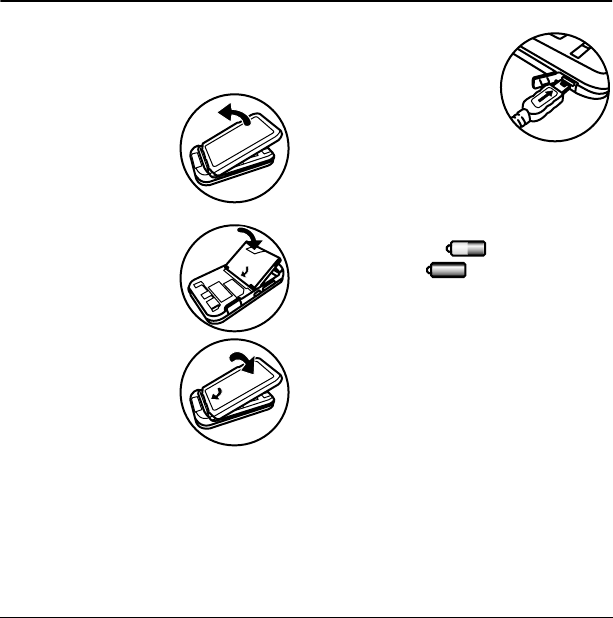
User Guide 1
1GETTING STARTED
Phone battery
Install the battery
To install the battery:
1. Hold the phone
face down.
2. Find notch on bottom
of the phone. Pull the
cover off.
3. Place the battery in the
phone casing with the
metal contacts facing
towards the bottom of
the phone.
4. Replace the battery
door by sliding the
notches into the
openings at the top the
battery casing.
5. Snap the cover into
place.
Charge the battery
You must have at least a partial charge in the
battery to make or receive calls.
To charge the battery:
1. Connect the AC adapter
to the microUSB jack
on the side of the
phone.
2. Plug the adapter into a
wall outlet.
The battery icon in the upper-right corner of the
screen tells you whether the phone is:
•Charging (the icon is animated)
•Partially charged
•Fully charged
Warning: The battery will not charge if you use
the phone while it is connected to an AC adapter.
Recharge the battery
You can safely recharge the battery at any time,
even if it has a partial charge.
Note: Before removing the battery, make sure the
phone is powered off.
Battery care
General safety guidelines
•Do not disassemble or open the battery.
•Do not crush, bend, deform, puncture, or
shred the battery.

2Phone battery
•Do not attempt to insert foreign objects into
the battery.
•Do not immerse the battery or expose it to
water or other liquids. Even if a battery
appears to dry out and operate normally,
internal parts can slowly corrode and pose a
safety hazard.
•Always keep the battery between 15×C and
25×C (59×F and 77×F). Do not expose the
battery to extremes of temperature (heat or
cold), fire, or other hazards such as a cooking
surface, iron, or radiator.
•Never use any damaged battery.
•Only use the battery for its intended phone.
•Only use the battery with a qualified charger.
Use of an unqualified battery charger may
present a risk of fire, explosion, leakage, or
other hazard. If you are unsure about whether
a charger is qualified, contact customer
support.
•Do not short-circuit the battery or allow
metallic conductive objects—such as keys,
coins, or jewelry—to contact the battery’s
terminals.
•Replace the battery only with another qualified
battery. Use of an unqualified battery may
present a risk of fire, explosion, leakage, or
other hazard. If you are unsure about whether
a replacement battery is compatible, contact
customer support.
•Promptly dispose of used batteries in
accordance with local regulations and recycle
if possible. Do not dispose as household
waste.
•Supervise all battery usage by children.
•Avoid dropping the phone or battery. If the
phone or battery is dropped, especially on a
hard surface, an internal short-circuit can
occur and pose a safety hazard. If you suspect
battery damage, take it to a service center for
inspection.
•Improper battery use may result in a fire,
explosion, or other hazard.
Common causes of battery drain
•Playing games or using the Web.
•Taking pictures with the flash on.
•Keeping backlighting on.
•Operating in digital mode when far away from
a base station or cell site.
•Using data cables or accessories.
•Operating when no service is available, or
service is available intermittently.
•High earpiece and ringer volume settings.
•Repeating sound, vibration, or lighted alerts.
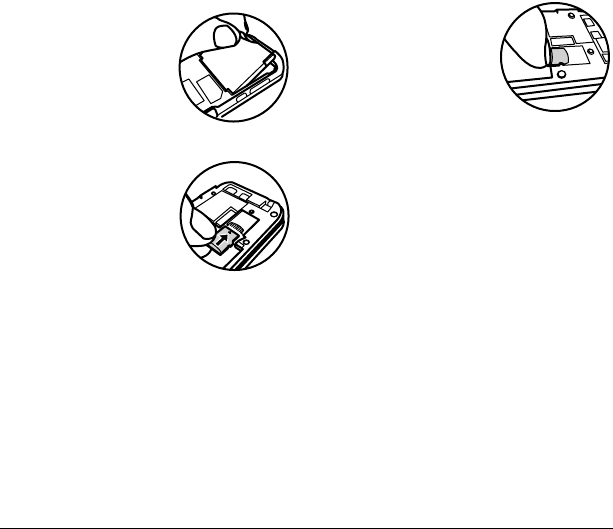
User Guide 3
Memory card
You can extend the phone’s memory with a
SanDisk microSD™ memory card.
Install the memory card
To install the memory card:
1. Hold the phone face
down.
2. Find notch on bottom
of the phone. Pull the
cover off.
3. Remove the battery.
Use the pull tab.
4. Slide the memory card
in the slot, with the
metal contacts facing
down.
5. Replace the battery in
the phone casing with
the metal contacts
facing towards the bottom of the phone.
6. Replace the battery door by sliding the
notches into the openings at the top the
battery casing.
7. Snap the cover into place.
Note: A notification appears when the card is
ready for use. Do not use the card until you see
the notification.
Remove the memory card
To remove the memory card:
1. Hold the phone face down.
2. Find notch on bottom of the phone. Pull the
cover off.
3. Remove the battery.
Use the pull tab.
4. Remove the memory
card from the slot.
Phone overview
Get to know your phone
The phone is shown here in the open position.
1. External earpiece.
2. Home screen.
3. Navigation key scrolls through lists and text
entry fields and accesses shortcuts from the
home screen.
4. Left softkey accesses menus and functions.
5. Send key starts or answers a call. Press once
to activate voice command, twice to display
the All Calls list, and three times to redial the
last number dialed. Press and hold to access
voice shortcuts.
6. Speakerphone key activates the
speakerphone and answers incoming calls.
7. Keypad for enters numbers, letters, or
symbols.
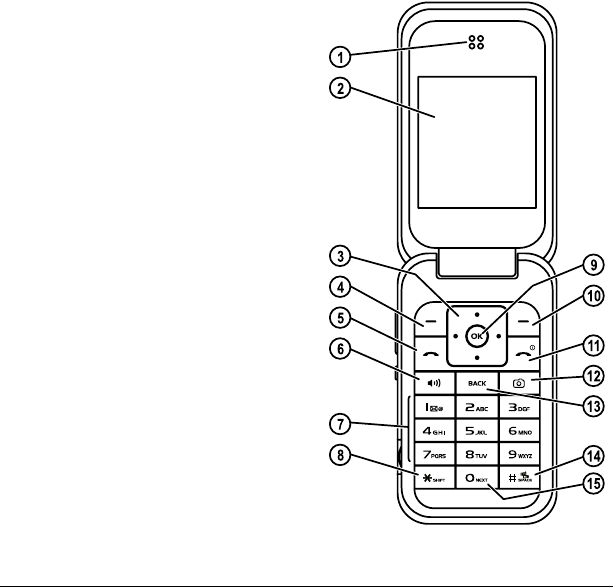
4Phone overview
8. Shift * key changes the text mode in text
entry.
9. OK key selects a menu item or option.
10. Right softkey accesses the Contacts directory
and other menu options.
11. End key turns the phone on and off, ends a
call or browser session, and returns you to
the home screen.
12. Camera key activates Camera mode. To
activate camera mode, press and hold the
Camera key.
13. Back key erases characters in text entry and
returns you to the previous screen when
navigating through menus.
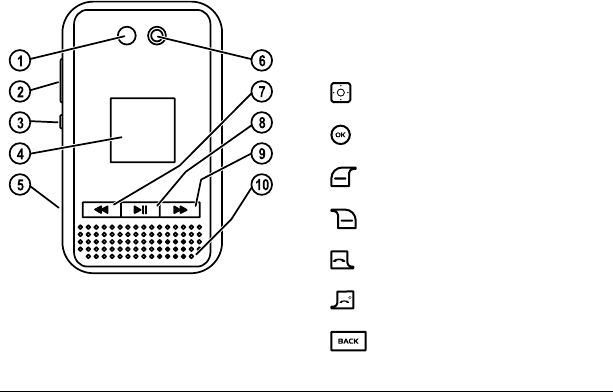
User Guide 5
14. Space # key enters a space during text entry.
Press and hold to activate or deactivate Silent
mode.
15. 0 Next key cycles through word choices
during text entry.
The phone is shown here in the closed position.
When the phone is closed, the keys are locked to
prevent accidental key presses.
1. Camera Flash/Message Indicator light flashes
when taking a picture or lights when you
have a message or missed call.
2. Volume key raises or lowers ringer volume.
3. External Camera key activates Camera mode.
To activate camera mode, press and hold the
Camera key.
4. External screen displays time, caller ID,
signal, and battery strength.
5. Jack for MicroUSB cable (sold separately).
6. Camera lens.
7. External Rewind key for the music player.
8. External Play / Pause key for the music
player.
9. External Fast Forward key for the music
player.
10. External speaker.
Common keys
The following keys are pressed frequently when
you use your phone. Throughout this user guide,
these keys will be referred as follows:
Navigation key
OK key
Left softkey
Right softkey
Send key (also referred to as the Talk key)
End key (also referred to as the Power key)
Back key
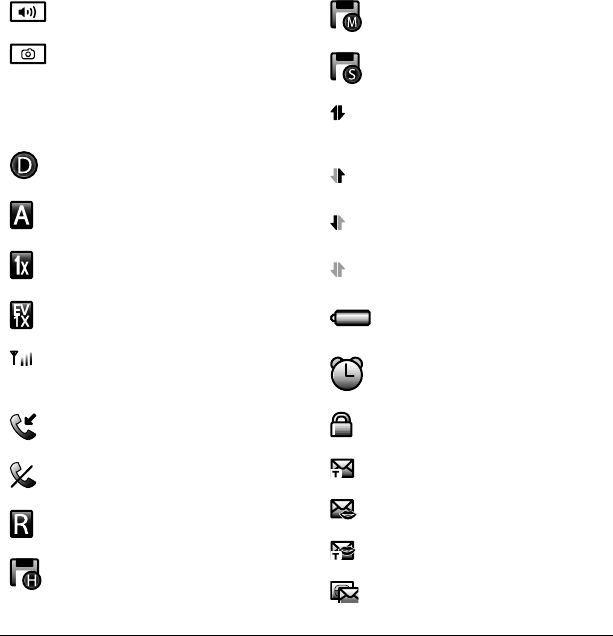
6Phone overview
Screen icons
These icons may appear on your phone’s screen:
Speakerphone key
Camera key
The phone is operating in IS95 digital mode.
The phone is operating in Analog (FM)
mode.
The phone is operating in IS2000 (1X)
digital mode.
The phone is operating in EVDO mode.
The phone is receiving a signal. You can
make and receive calls. Fewer bars indicate
a weaker signal.
A call is in progress.
The phone is not receiving a signal. You
cannot make or receive calls.
The phone is roaming outside of its home
service area.
The phone has a high speed data
connection.
The phone has a medium speed data
connection.
The phone has a standard speed data
connection.
Data service is available and active on your
phone. Check with your service provider for
availability.
(blinking) The phone is sending high-speed
data.
(blinking) The phone is receiving high-
speed data.
Data service is available, but the phone is
dormant.
The battery is fully charged. The more black
bars, the greater the charge.
The alarm clock is set.
The phone is in privacy mode or is accessing
a secure Web site.
New text message.
New voice message.
New voice and text message.
New photo message.
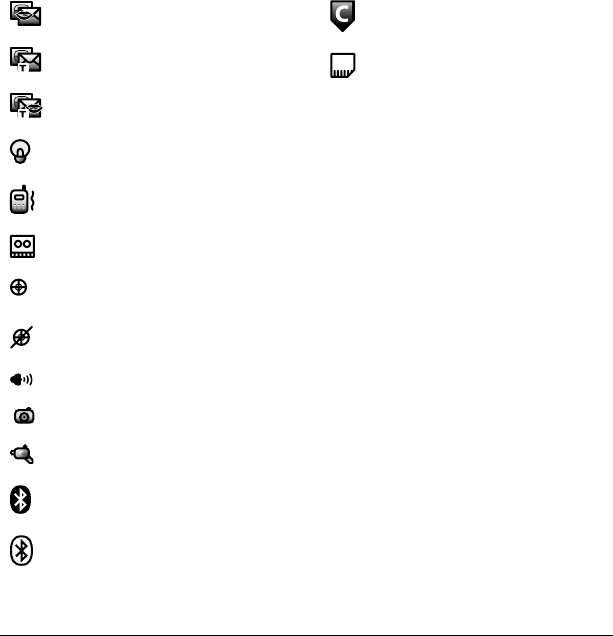
User Guide 7
New photo and voice message.
New photo and text message.
New photo, voice and text message.
The phone is set to light up instead of ring.
The phone is set to vibrate or to vibrate and
then ring.
The phone is set to auto answer.
Position location is set to your service
provider and to emergency services.
Position location is set to emergency services
only.
The speaker phone is turned on.
The phone is in camera mode.
The phone is in video mode.
Bluetooth wireless technology is enabled
(On).
Bluetooth wireless technology is disabled
(Off).
Content is DRM protected.
Content is located on the memory card.

8Main menu
Main menu
The contents of the main menu are as follows:
Basic navigation
Pressing your phone keys accesses the various
menus and other features of your phone. Some of
the basic keys that are used frequently are:
•Left softkey: Selects items that appear on the
lower left of the display. At the home screen,
you can select Menu.
•Right softkey: Selects items that appear on
the lower right of the display. At the home
screen, you can select Contacts.
•Navigation key: Scrolls through menus and
options. You can access the following
shortcuts from the home screen.
–Scroll left launches the browser.
–Scroll right records a voice memo.
–Scroll up displays a custom menu.
Recent Calls
All Calls
Incoming
Outgoing
Missed
Erase Call List
Call Timer
Contacts
View All
Add New
View Groups
Speed Dial List
Voice Dial List
Contacts Count
Camera
Launches the Camera
Media Galley
Images
Sounds
Videos
Messaging
New Text Msg
New Pix Msg
Voicemail
Inbox
Browser Alerts
Sent Msgs
Outbox
Saved Msgs
Drafts
Msg Settings
Erase Msg
Settings
Bluetooth
Sounds
Alerts
Display
My Phone
Network
Security
Accessories
USB Mode
Tools
Voice Memo
Scheduler
Alarm Clock
Tip Calculator
Calculator
Timer
Stopwatch
Memopad
World Clock
Browser
Launches the Browser
Downloads
MobileShop
Settings
Help
Music Player
Launches the music player
Note: The menu items on your phone can change depending on the services provided by your service provider.
Check with your service provider.

User Guide 9
–Scroll down displays the recent calls list.
•OK key: Selects a menu item. You can activate
the music player when you press the OK key
from the home screen.
•Back key: Returns to the previous menu level.
•End key: Returns to the home screen.
Guide conventions
In this guide, the following conventions are used
when describing phone features.
Select means to press the left softkey, right softkey
or OK key to select an item seen on the display.
For example, “Select Menu” tells you to physically
press the left softkey to choose Menu from the
display.
Press means to press a phone key. For example,
“Press the Send key to make a phone call” tells
you to physically press the Send key on your
phone.
Scroll means to use the Navigation key to move
though a list on the display. For example, “Scroll
through your Contacts list to choose a contact”
means to physically press the Navigation key up
or down to scroll through the list on the display.
> (greater than symbol) tells you to select an
option from a menu or list. For example, “Menu
> Settings” means to:
1. Press the left softkey to select Menu.
2. Scroll to the Settings option.
3. Press the left softkey to select Settings.

10 Power up
2BASIC FUNCTIONS
This section explains basic functionality of your
phone. For more detailed explanations of your
phone’s features, please refer to later chapters.
Power up
To turn your phone on, press and hold the End
key and wait until the phone display lights up.
To turn your phone off, press the hold the End
key until the phone plays a musical chime and
turns off.
Make phone calls
Make sure you are in an area where a signal can
be received. Look for the signal strength icon on
the home screen. The more bars you see in this
symbol, the stronger the signal. If there are no
bars, move to where the signal strength is better.
When the phone has been idle for a time, it
changes to power save mode. When you see
“Power Save” on your phone’s screen, press any
key to return to normal operating mode.
There are several ways you can make a phone
call.
Call using a number
1. Enter a phone number.
2. Press the Send key.
Call using a contact
1. Select Contacts to open your Contacts list.
2. Highlight a contact and press the Send key.
Call using voice commands
You can use voice commands to call a contact
from your voice dial list or to dial a phone
number. For more information, see “Voice
Commands” on page 71.
Redial a number
1. Press the Send key twice to open your call
history.
2. Highlight a phone number or contact and
press the Send key.
Tip: To redial the last number called, received or
missed, press the Send key three times.
Answer phone calls
When a call comes in, the phone rings, vibrates,
or lights up. The phone number of the caller also
appears if it is not restricted. If the number is
stored in your Contacts directory, the contact’s
name appears.
There are several ways you can answer a phone
call.
Answer using earpiece
Press the Send key.

User Guide 11
Answer using speakerphone
Press the Speakerphone key.
Answer using flip
You can set the phone to answer immediately
when you open the flip. This feature does not
apply to incoming data or fax calls. For more
information, see “Open to answer” on page50.
End phone calls
To end a phone call press the End key.
Verify your phone number
To verify your phone number, select Menu >
Settings > My Phone > Phone Info > Build
Info.
Activate voice dialing
1. Press the Send key once.
2. Follow the prompts.
For more information, see “Voice Commands” on
page 71.
Take a picture
1. Press and hold the Camera key to start the
camera.
2. Focus on the image and select Capture.
For more information, see “Camera” on page 26.
Create a custom menu
1. From the main screen, scroll up and hold.
2. Select Edit.
3. Select features from the list provided. A
check mark appears next to each selection
you make. You can also remove checkmarks.
4. When you have chosen your menu options,
select Save.
You new selection appear the next time you select
your custom menu.

12 Volume control
3CALL FEATURES
This chapter describes call features such as
volume, holding calls, speed dialing and other
features.
Volume control
There are several ways to control the volume of
your phone.
Adjust volume during a call
To adjust the earpiece volume during a call, press
the Volume key up or down.
Use the speakerphone
Your phone has a built-in speakerphone. To turn
on the speakerphone, press the Speakerphone
key.
The speakerphone icon appears on the home
screen when the speakerphone is on.
To turn off the speakerphone, press the
Speakerphone key
Note: If you press the Speakerphone key during
an incoming call, you will answer the call.
Silence an incoming call
To silence the phone without answering the call
press the End key or select Silence.
To silence the phone and answer the call, press
the End key and then press the Send key.
Note: In the absence of voicemail, this feature
drops the call.
Hold call
The Hold Call feature allows you to place
incoming calls on hold until you are ready to
answer them. See “Hold calls” on page 49.
Speed dialing
The Speed Dial feature allows you to assign a one-
or two-digit shortcut to a contact. Before you can
use speed dialing you must save a phone number
as a contact and assign a speed dial location to it.
See “Customize a number” on page 21.
To call a contact that has a speed dial location.
1. Enter the one- or two-digit speed dial
location.
2. Press the Send key.
1-Touch dialing
The 1-Touch Dialing feature is the fastest way to
speed dial a contact that has a speed dial location.
See “1-Touch dialing” on page 49.
Voicemail
Configure your voicemail
Before your phone can receive voicemail
messages, you must set up a password and record

User Guide 13
a personal greeting with your service provider.
When you have set up your voicemail, all
unanswered calls to your phone are automatically
transferred to voicemail, even if your phone is in
use or turned off.
1. Press and hold the 1 key.
2. Follow the system prompts to create a
password and record a greeting.
Check you voicemail
When a voice message is received, your screen
displays a notification along with a voicemail
message icon at the top of your screen. The
symbol flashes if the message is urgent. If you see
a notification:
1. Select Call, which initiates a call to your
voicemail number.
2. Follow the system prompts to retrieve the
message.
Note: To clear the screen without checking
messages, select Ignore.
If you see only the voicemail message icon:
1. Select Menu > Messaging > Voicemail.
2. Follow the system prompts to retrieve the
message.
Set voicemail alert
You can set the phone to beep or vibrate every five
minutes to remind you that you have voicemail.
For more information, see “Alerts” on page 46.
Data and fax calls
Your phone may be able to receive certain data or
faxes. See “Data and Fax Calls” on page 52.
Roaming calls
Set roaming alert
You can set phone to alert you when you roam
outside of your home service area. See “Roaming
Service Alert” on page 53.
Set roam ringer
You can set a ringer to indicate when an incoming
call will be subject to roaming charges. See
“Roam ringer” on page 44.
Set call guard
You can set the phone to warn you before you
answer or place a call while roaming. See “Roam
Call Alert” on page 54.
Emergency services
Call emergency service
You can call an emergency code, even if your
phone is locked or your account is restricted.
When you call, your phone enters Emergency
mode. This enables the emergency service
exclusive access to your phone to call you back, if
necessary. To make or receive regular calls after
dialing the code, you must exit this mode.

14 Airplane mode
To place dial an emergency code:
1. Enter your 3-digit emergency code.
2. Press the Send key.
Note: Regardless of your 3-digit emergency code
(911, 111, 999, 000, etc.), your phone operates
as described.
Exit emergency services
When you have completed the emergency call:
1. Select Exit.
2. Select Exit again to confirm your choice.
Note: To determine who has access to your
location, see “Location” on page 54.
Airplane mode
While in an airplane, you can set your phone to
Airplane mode where your phone does not emit
RF signals. See “Airplane mode” on page 48.
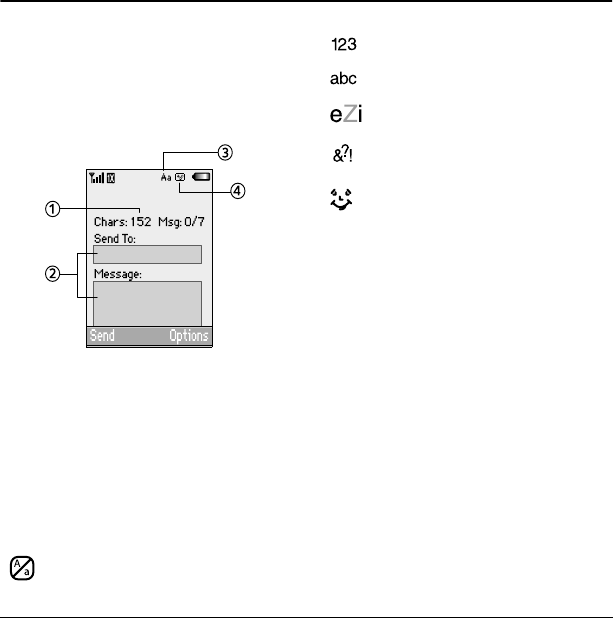
User Guide 15
4TEXT ENTRY
You can enter letters, numbers, and symbols in
contacts, text messages, and your banner.
Text entry modes
The current text entry mode (and capitalization
setting, when applicable) are indicated by icons.
The text entry screen has the following features:
1. Characters remaining that you can type.
Allowed length of messages can vary
depending on your service.
2. Text entry fields.
3. Current capitalization setting.
4. Current text entry mode.
There are six text entry modes:
Note: The mode you start in depends on the task
you are doing. For example, when entering a
phone number, you’re in Numbers Only mode.
When entering a name for a contact, you’re in
normal text mode.
Enter numbers
•To enter a number while in Numbers Only
mode, press a number key once.
•To enter a number while in Normal Alpha or
Rapid Entry mode, press and hold a number
key until the number appears on the screen.
Enter words letter by letter
1. Press a key once for the first letter, twice for
the second letter, and so on. If your phone is
set to Spanish, French, or Portuguese,
accented letters are available.
Case Change
Numbers Only
Normal Alpha
Rapid Entry
Add Symbol
Add Smiley

16 Text entry modes
2. Wait for the cursor to move right and enter
the next letter.
Note: To enter a space, press Space # key.
Enter words quickly
When you press a series of keys using Rapid Entry
mode, your phone checks its dictionary of
common words and guesses at the word you are
trying to spell.
1. For each letter of the word you want, press
the key once. For example, to enter the word
“any” press the 2 > 6 > 9 keys.
2. If the word doesn’t match what you want,
press 0 Next key to look at other word
matches.
3. When you see the word you want, press the
Space # key.
Enter symbols
While entering text in Normal Alpha mode, you
can enter symbols by pressing the 1 key until you
see the symbol you want. Using this method, you
have access to the following symbols:
. @ ? ! - , & : ‘ ]
To access the full set of symbols:
1. From the text entry screen select Options >
Add Symbol.
2. Scroll up or down to view the list of symbols.
3. Press the number key corresponding to the
symbol to enter it.
Enter smileys
1. From the text entry screen select Options >
Add Smiley.
2. Scroll up or down to view the list of smileys.
3. Press the number key corresponding to the
smiley to enter it.
Change default text entry mode
You can change the default text entry mode when
creating a text message. For more information,
see “Default text” on page 40.
Change modes
Sometimes you need to change modes. For
example, to enter numbers in an email address
while in Normal Alpha mode, you must change to
numbers only mode, enter the numbers, and then
change back to Normal Alpha mode to complete
the address.
To change text entry modes, press and hold
Shift * key until the icon for the mode you want
appears at the top of the screen. You can also
select Options then select a different mode.
Capitalization
You can change capitalization at any time while
entering text. Simply press the Shift * key to
choose upper or lower case while in Normal
Alpha mode.

User Guide 17
Text entry quick reference
This table gives instructions for entering letters,
numbers, and symbols.
To.. Do this...
Enter a letter Use Normal Alpha mode and press a key until you see the letter your want.
For more options, see “Text entry modes” on page 15.
Enter a number Use Numbers Only mode and press a key. For more options, see “Text
entry modes” on page15.
Enter a symbol In either Normal Alpha or Numbers Only mode, press the 1 key until you
find the symbol you want. For more options, see “Text entry modes” on
page 15.
Enter a smiley Use the Add Smiley feature.
Enter a space Press the Space # key.
Erase a character Press the Back key.
Erase all characters Press and hold the Back key.
Move cursor right or left Scroll left or right.
Move cursor up or down Scroll up or down.
Change text entry modes Press and hold the Shift * key.
Capitalize any letter In normal alpha mode, press the Shift * key. Choose uppercase.
Lowercase any letter In normal alpha mode, press the Shift * key. Choose lowercase.
Initial caps In normal alpha mode, press the Shift * key. Choose sentence case.
Select soft options on screen Press the appropriate left or right softkey.

18 Call lists
5RECENT CALLS
Call lists
Details on the calls you made, received, or missed
are stored in the Recent Calls list and are
identified by the following icons:
View recent calls
1. Select Menu > Recent Calls and one of the
following:
–All Calls to view all calls made or
received.
–Incoming to view calls answered.
–Outgoing to view calls made.
–Missed to view calls received, but not
answered.
2. Highlight a recent call.
3. Press the Send key to call the number or
select Options and one of the following:
–Save creates a new contact.
–View displays the contact details.
–Send Text Msg sends a text message to
the number.
–Send Picture Msg sends a multimedia
message to the number.
–Erase Record deletes the call from the
call list.
Note: If the phone number is classified as
“secret,” you must enter your four-digit lock code
to view or edit it.
Deal with a missed call
When you have missed a call, “Missed Call”
appears on your screen. You can do one of the
following:
•To clear the screen, select OK.
•To view the call details, select Calls and press
the OK key.
•To return the call, select Calls and press the
Send key.
Set alert for missed calls
You can set an alert to beep every five minutes
after you have missed a call. See “Alerts” on
page 46.
Outgoing call
Incoming call
Missed call (flashing)

User Guide 19
Erase call lists
You can erase your phone’s call lists.
1. Select Menu > Recent Calls > Erase Call
List > All, Incoming, Outgoing, or Missed.
2. Select Yes.
Call timers
View call timers
Select Menu > Recent Calls > Call Timer and
one of the following:
•All tracks all calls you have made and
received. This timer cannot be reset.
•Recent tracks all calls you have made and
received since you last reset this timer. To
reset this timer to zero, select Reset.
•Home tracks all calls you have made and
received in your home network since you last
reset this timer. To reset this timer to zero,
select Reset.
•Roam tracks all roaming calls you have made
and received since you last reset this timer. To
reset this timer to zero, select Reset.
Time your calls
Your phone can alert with a short beep ten
seconds before each minute passes during a call.
For more information, see “Minute alert” on
page 50.

20 View contacts directory
6CONTACTS
Use your phone’s Contacts directory to store
information about a person or company. Each
contact entry can have up to six phone numbers,
two email addresses, two Web addresses, two
street addresses, and a space for notes.
View contacts directory
To view existing contacts in your phone, select
Menu > Contacts > View All. Your Contacts
directory is listed alphabetically
Tip: You can also select Contacts from the home
screen to view the directory.
Scroll to a contact and do one of the following:
•Press the Send key to call the highlighted
contact.
•Press the OK key to view the highlighted
contact’s detail.
•Select New to add a new contact.
•Select Options and choose one of the
following:
–Call sends a call.
–Send Text Msg sends a text message.
–Send Pict Msg sends a multimedia
message.
–View Contact views contact.
–Edit Contact edits the contact.
–Erase Contact deletes the contact.
–Send as vCard sends contact as a vCard.
–Send All sends all contacts to a Bluetooth
device or a connected printer.
–Contact Menu accesses the contact menu.
Add contacts
Add contact from home screen
To add a contact to your Contacts directory:
1. From the home screen, enter a phone
number to save (include the area code).
2. Select Save > Save New Contact.
3. Enter a name for the contact. For more
information, see “Text Entry” on page 15.
4. Enter additional phone numbers, email
addresses, Web addresses and note, if
needed. Scroll up or down to move through
the contact fields.
5. When you are done entering information,
select Save.
Add contact from contacts menu
To add a contact to your Contacts directory:
1. Select Menu > Contacts > Add New.
2. Enter a name for the contact. When you are
done scroll down to move the next field. For
more information, see “Text Entry” on
page 15.
3. Enter a primary number for the contact.

User Guide 21
4. Enter additional phone numbers, email
addresses, Web addresses and note, if
needed. Scroll up or down move through the
contact fields.
5. When you are done entering information,
select Save.
Add code or extension
When you save the phone number of an
automated service, you may include a pause to
stop dialing. For example, a pause where you
would wait to dial an extension.
1. From the home screen, enter a phone
number.
2. Select Options and a type of pause:
–Time Pause causes the phone to stop
dialing for two seconds.
–Hard Pause causes the phone to stop
dialing until you select Release while
making the call.
3. Enter the remaining numbers and select
Save > Save New Contact.
4. Complete the contact and select Save.
Customize contacts
Edit contact details
To edit details of an existing contact.
1. Select Menu > Contacts > View All.
2. At the Contacts directory, select a contact.
3. At the contact’s detail screen, select Edit.
4. Edit or add phone numbers, email
addresses, Web addresses and notes. Scroll
up or down move through the contact fields.
5. When you are done entering information,
select Save.
Customize a contact
To customize the name of an existing contact.
1. Select Menu > Contacts > View All.
2. At the Contacts directory, select a contact.
3. At the contact’s detail screen, scroll to the
contact name.
4. Select Options and one of the following:
–Ringer assigns a specific ringer to the
contact.
–Picture assigns a specific picture to the
contact.
–Erase Contact deletes the contact. This
will erase the entire contact.
–Send as vCard sends the contact as a
vCard.
–Voice Dial enable or disable the
contact’s voice tag.
Customize a number
To customize the number of an existing contact.
1. Select Menu > Contacts > View All.
2. At the Contacts directory, select a contact.

22 Customize contacts
3. At the contact’s detail screen, scroll to a
contact number.
4. Select Options and one of the following:
–Call sends a call.
–Send Text Msg sends a text message.
–Send Pict Msg sends a multimedia
message.
–Prepend displays the contact’s detail
screen for you to change the number
(adding an area code) or other data of
the contact.
–Add Speed Dial adds the number to your
speed dial list.
–View Number displays the number.
–Erase Number deletes number from the
contact.
–Secret / Not Secret makes the number
secret. It will not appear on the screen
until the lock code is entered. Secret
numbers can be called without a lock
code.
–Primary Number makes this number the
primary number for the contact.
–Send as vCard sends the contact as a
vCard.
–Add To Group adds the number to the
business, personal or custom group.
Customize an email address
To customize the email address of an existing
number.
1. Select Menu > Contacts > View All.
2. At the Contacts directory, select a contact.
3. At the contact’s detail screen, scroll to a
contact email address.
4. Select Options and one of the following:
–Send Text Msg sends a text message.
–Send Pict Msg sends a multimedia
message.
–View Address displays the email
address.
–Add To Group adds the email address to
the business, personal or custom group.
–Erase Address deletes email address
from the contact.
–Secret / Not Secret makes the email
address secret. It will not appear on the
screen until the lock code is entered.
–Send as vCard sends the contact as a
vCard.
Customize a Web address
To customize the Web address of an existing
number.
1. Select Menu > Contacts > View All.
2. At the Contacts directory, select a contact.
3. At the contact’s detail screen, scroll to a
contact Web address.

User Guide 23
4. Select Options and one of the following:
–Launch Web launches the Web browser
and goes to Web address.
–Send Pict Msg sends a multimedia
message.
–View Web displays the Web address.
–Erase Web deletes Web address from the
contact.
–Secret / Not Secret makes the Web
address secret. It will not appear on the
screen until the lock code is entered.
–Send as vCard sends the contact as a
vCard.
Customize a street address
To customize the street address of an existing
number.
1. Select Menu > Contacts > View All.
2. At the Contacts directory, select a contact.
3. At the contact’s detail screen, scroll to a
contact email address.
4. Select Options and one of the following:
–View Address displays the street
address.
–Erase Address deletes street address
from the contact.
–Secret / Not Secret makes the street
address secret. It will not appear on the
screen until the lock code is entered.
–Send as vCard sends the contact as a
vCard.
Customize a note
To customize the note of an existing number.
1. Select Menu > Contacts > View All.
2. At the Contacts directory, select a contact.
3. At the contact’s detail screen, scroll to a
contact email address.
4. Select Options and one of the following:
–View Note displays the note.
–Erase Note deletes the note from the
contact.
–Secret / Not Secret makes the note
secret. It will not appear on the screen
until the lock code is entered.
–Send as vCard sends the contact as a
vCard.
Assign ringer to a contact
To assign a ringer to a contact.
1. Select Menu > Contacts > View All.
2. At the Contacts directory, select a contact.
3. At the contact’s detail screen, scroll to the
contact name.
4. Select Options > Ringer > Assign Ringer
and a ringer from the list. Scroll to play the
files.

24 Contact groups
Assign picture to a contact
To assign a picture to a contact.
1. Select Menu > Contacts > View All.
2. At the Contacts directory, select a contact.
3. At the contact’s detail screen, scroll to the
contact name.
4. Select Options > Picture > Assign Picture
> Images > Camera Pictures.
Note: Select Options > Picture > Take
Picture Now to take a new picture.
5. Scroll to an image and select Assign.
Note: With Mobile Phone Tools (MPT) for
Kyocera you can transfer digital pictures to your
phone. To purchase MPT or other accessories
visit www.kyocera-wireless.com/store.
Assign number type
When you assign a number type, an icon is placed
in front of the contact number to specify the type
of number it is.
1. Select Menu > Contacts > View All.
2. At the Contacts directory, select a contact.
3. At the contact’s detail screen, select Edit.
4. Press down twice to scroll to the number
type dropdown and press the OK key.
5. Select General, Work, Home, Mobile,
Pager or Fax. The appropriate icon will
appear next to the number in your phone
lists.
6. Select Save.
Send a vCard
To send contact information as a message:
1. Select Menu > Contacts > View All.
2. At the Contacts directory, select a contact.
3. Select Options > Send as vCard and one of
the following:
–via MMS
–via Bluetooth
–To Printer
4. Complete the appropriate task to send
contact information.
Contact groups
You can assign your contacts to groups. Your
phone comes with two default groups, Business
and Personal. You can also create your own
groups.
Create a group
1. Select Menu > Contacts > View Groups.
2. Select New.
3. Enter a name for the group, then select Next.
4. Select contacts from the list provided. A
check mark appears next to each selection
you make. You can also remove checkmarks.
5. When you have chosen your contacts, select
Done.

User Guide 25
You new group appears the next time you view
your groups.
Use a group
1. Select Menu > Contacts > View Groups.
2. At the Groups list, scroll to a group.
3. Select Options and one of the following:
–View displays the group details.
–Edit edits the group.
–Erase deletes the group.
–Send Text Msg sends a text message.
–Send Pict Msg sends a multimedia
message.
–Send as vCard sends the group as a
vCard.
Customize a group
1. Select Menu > Contacts > View Groups.
2. At the Groups list, select a group.
3. Select Options and one of the following:
–Ringer assigns a ringer to the group.
–Picture assigns a picture to the group.
–Erase deletes the group.
–Edit edits the group.
Search contacts
To find a phone number or contact, you can
search the Contacts directory, check the Frequent
List, or use Fast Find.
Contacts directory
To search your contacts directory, select Menu >
Contacts and one of the following:
•View All lists the entire Contacts directory.
•View Groups lists existing groups.
•Speed Dial List or Voice Dial List shows
contacts on the specified list.
You can also use the Contacts shortcut from the
home screen to view the Contacts directory. To
quickly get down the list, enter the first letter of
the contact. You will skip to that letter of the
alphabet.
Frequent list
With Frequent List enabled, you can see 15 of
your most frequently called contacts. For more
information, see “Frequent list” on page 50
Fast find
With Fast Find enabled, you can press one or two
keys to view close matches of the number. For
more information, see “Fast find” on page 50.
Voice search
You can use voice commands to find a contact in
your voice dial list. For more information, see
“Find contacts” on page 72.
Contacts space
Check how much space you have for contacts.
Select Menu > Contacts > Contacts Count.

26 Take a picture
7CAMERA
You phone comes with a camera. Before using
your phone’s camera, here are some tips:
•You cannot activate the camera while on an
active call or while browsing files in the media
gallery.
•Once the camera is active, the home screen
acts as the viewfinder.
•If you get a “Low memory” error, check your
resolution and quality compression settings.
See “Setting up the camera for photos” on this
page.
•If there is no activity within 45 seconds after
you turn your camera on, the camera quits
and returns to the previous launch point.
•Menu settings and options can only be
accessed when the camera is active.
Take a picture
To take a picture:
1. Activate the camera one of the following
ways:
–Press the Camera key until you hear two
beeps.
–Select Menu > Camera.
2. Focus on the image using the phone’s display
as a viewfinder. Scroll up or down to zoom in
and out.
3. Take a picture one of the following ways:
–Press the OK key.
–Press the Camera key.
–Select Capture.
The picture is saved to your Camera Pictures.
4. Select Send to create a multimedia message
or Erase to delete the picture from your
phone.
5. Press the End key to exit camera mode.
Camera mode options
You can set up how your camera takes pictures.
While in camera mode, select Options and one of
the following:
•Settings displays the following settings you
may set up prior to taking a picture:
–Flash sets the flash. Options are
Automatic, On, or Off.
–Resolution adjusts the resolutions.
–Low Light Mode brightens the picture for
low light environments.
–Self Timer sets a self timer. Options are
Off (default) or 3, 5, or 10 second pauses.
When set, the camera beeps from 3
seconds down to the time the shutter
snaps the picture automatically. Self Timer
is not available when Multishot mode is
activated.

User Guide 27
–Multishot allows you to take up to six
multiple pictures while the camera key is
pressed and held. A tone will play each
time a picture is taken. A second tone will
play when the final picture is taken.
–Shutter Sound sets the sound used when
the camera takes a picture.
–White Balance adjusts for different
lighting.
–Color Tone sets the color tone of the
picture.
–Quality sets the picture compression. The
higher the compression, the better the
detail of the picture (higher pixel rate).
When set to High, the picture file size is
larger, using more memory.
–LED flashes a light to indicate a picture
has been taken. Options are On and Off
(default).
–Save Location choose whether to save
new pictures to the phone or memory
card.
•Video Mode toggles between video and
camera modes.
•Brightness adjusts the brightness of the image
in the home screen LCD.
•Camera Pictures displays all pictures taken
and stored.
•Last Picture displays the most recently taken
picture.
•Frames adds a frame or a stamp to your
picture. A frame or stamp cannot be removed
once it has been used in a picture. The picture
resolution changes to 160 x 120 while taking
pictures with frames. The resolution returns
to the original setting once Frames is disabled.
Note: The following settings will revert to the
default setting each you exit the camera
application: Low Light Mode, Self Timer, and
MultiShot.
Record a video
To record a video:
1. Activate the camera one of the following
ways:
–Press the Camera key until you hear two
beeps.
–Select Menu > Camera.
2. Select Options > Video Mode.
3. Focus on the image using the phone’s display
as a viewfinder.
4. Select Record. You can do the following
while recording:
–Scroll up or down to zoom in and out.
–Select Pause to pause recording.
–Select Resume to resume recording.
5. When you are finished recording, select
Stop. The recording is saved to your Video
Album.
6. Press the End key to exit video mode.
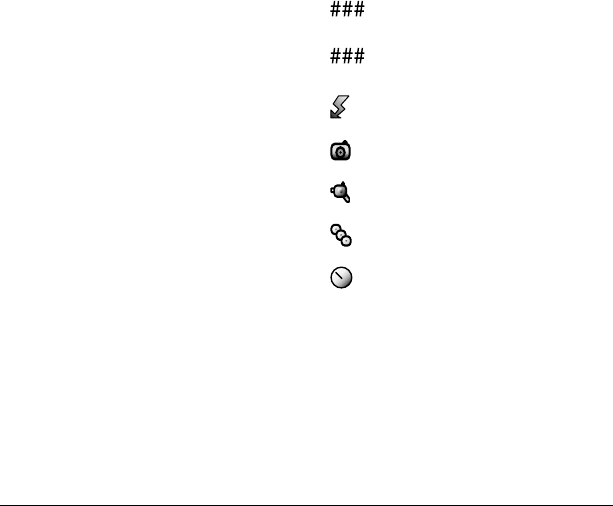
28 Video mode options
Video mode options
You can set up how your camera takes videos.
While in camera mode, select Options and one of
the following:
•Settings displays available camera settings
you may set up prior to recording a video,
which include:
–White Balance adjusts for different
lighting. Scroll through options.
–Quality sets the video compression. The
higher the compression, the better the
detail of the video (higher pixel rate).
When set to High, the video file size is
larger, using more memory.
–LED flashes a light to indicate a video has
been taken. Options are Off (default) and
On.
–Recording Light turns on a light for
recording. Options are On and Off
(default).
–Recording Sound turns on a tone that
signals the start and end of a recording.
Options are On (default) and Off.
–Save Location choose whether to save
new videos to the phone or memory card.
•Camera Mode toggles between video and
camera modes.
•Brightness adjusts the brightness of the image
in the home screen LCD.
•Video Album displays all videos taken and
stored.
•Last Video displays the most recently taken
video.
Camera indicators and icons
The camera displays the following on screen
indicators and icons.
Numbers in the top right corner indicate the
number of snapshots remaining.
Numbers in the bottom left corner indicate
the resolution setting for pictures.
Flash on.
Camera is in camera mode.
Camera is in video mode.
Multishot feature is on.
Self-timer feature is on.

User Guide 29
8MEDIA GALLERY
Your phone stores images, sounds and videos and
can display those files on the phone’s screen.
Access folders
To access the folders where your phone stores
media files, select Menu > Media Gallery and
one of the following:
•Images contains images files that are
preloaded, downloaded, saved or created.
•Sounds contains sound files that are
preloaded, downloaded, saved or created.
•Videos contains video files that are preloaded,
downloaded, saved or created.
Browse images
To browse the Images folder:
1. Select Menu > Media Gallery > Images and
one of the following:
–Camera Pictures displays thumbnails of
the photos you have taken.
–Saved Images displays images available.
–Wallpapers displays wallpaper available.
–Screensavers displays screensavers
available.
–Caller IDs displays the IDs you have
assigned to pictures and images.
–Frames displays frames used for framing
images.
2. At image list, scroll to an image and select
View.
3. Select Send to create a message with the
image attached or select Options and one of
the following:
–Erase deletes the image.
–Assign assigns the image as a Caller ID,
wallpaper, or screensaver.
–Slideshow starts a slideshow beginning
with the selected image.
–Modify > Options > Rotate rotates the
picture. Options include 90° right, 180°,
90° left, flip horizontal or flip vertical.
–Modify > Options > Resize resizes the
image. Options include 90%, 75%, 50%
or 30%.
–Modify > Options > Brightness adjusts
the brightness.
–Modify > Options > Saturation adjusts
the saturation.
–Modify > Options > Sharpness adjusts
the sharpness.
–Modify > Options > Hue adjusts the
hue.
–Modify > Options > Auto Adjust
automatically adjusts all levels.

30 Browse sounds
–Modify > Options > Color Tone adjusts
the color tone. Options include
grayscale, negativem sepia, or emboss.
–Zoom zooms in or out on the image.
–Set Default assigns the image as a
wallpaper or screensaver.
–Send to Online uploads a file to an
online server.
–Move File transfers file to or from
memory card.
–Copy File copies file to or from memory
card. File will appear twice in folder.
–Take picture activates camera mode.
–Lock \ Unlock prevents accidental
erasing of the image.
–Rename renames the image.
–Details displays details of the file.
–Erase All deletes all images stored.
Browse sounds
To browse the Sounds folder:
1. Select Menu > Media Gallery > Sounds and
one of the following:
–Saved Sounds displays sounds available.
–Music displays music files available.
–Ringers displays ringers available.
–Voice Memos contains voice memos you
have made.
2. At folder list, scroll to a file.
3. Select Send to create a message with the
sound attached or select Options and one of
the following:
–Play plays a sound or music file.
–Play All plays all music files.
–Record New records a new voice memo.
–Erase deletes the sound.
–Assign assigns the sound to a contact.
–Send to Online uploads a file to an
online server.
–Move File transfers file to or from
memory card.
–Copy File copies file to or from memory
card. File will appear twice in folder.
–Lock / Unlock prevents accidental
erasing of the sound.
–Rename renames the sound.
–Details displays details of the file.
–Erase All deletes all sounds stored.
Browse videos
To browse the Videos folder:
1. Select Menu > Media Gallery > Videos and
one of the following:
–Video Album displays videos recorded
with your camera.
–Saved Videos displays videos you have
saved.
2. At folder list, scroll to a file.

User Guide 31
3. Select Play to review the video or select
Options and one of the following:
–Send creates a message with the video
attached.
–Record New to record a new video.
–Erase deletes the video.
–Send to Online uploads a file to an
online server.
–Move File transfers file to or from
memory card.
–Copy File copies file to or from memory
card. File will appear twice in folder.
–Lock / Unlock prevents accidental
erasing of the video.
–Rename renames the video.
–Details displays at details of the file.
–Erase All deletes all videos stored.
Playback tools
When you playback either a sound or video file,
use the Navigation key to select the playback tools
displayed on the screen.

32 Text messages
9MESSAGING
This chapter describes how to send, receive, and
erase messages from your phone. For information
on voicemail messages, see “Voicemail” on
page 12.
Note: The features and menus described in this
chapter may vary depending on services available
in your area. Check with your service provider for
details and possible usage charges.
Text messages
You can only send text messages to phones that
are capable of receiving them or to email
addresses.
Create a text message
1. Select Menu > Messaging > New Text Msg.
2. At the Send To field, enter a recipient’s phone
number or email address by either:
–Select Options > Recent List, Recent
Calls, Contacts or Groups accesses your
stored contacts.
–Enter a new address manually. See “Text
Entry” on page 15.
You can message up to ten recipients at
once. Use comma or spaces to separate
addresses. If you select stored contacts, this
is done automatically. Scroll down to move to
the next field when done.
3. At the Message field, enter the message.
4. Select Send.
Include QuickText and other extras
During text entry, you can insert prewritten text
(QuickText), symbols or smileys
1. From the text entry screen, select Options
and one of the following:
–Insert QuickText inserts prewritten text
from a list.
–Insert Contact inserts a contact detail.
–Add Symbol inserts a symbol. Press the
corresponding number to select a
symbol.
–Add Smiley inserts a smiley. Press the
corresponding number to select a smiley.
If you have enhanced messaging, you also
have the following options:
–Insert Picture inserts a picture.
–Insert Sound inserts a sound.
2. Complete your message.
3. Select Send.

User Guide 33
Use text message options
When you are ready to send a text message, you
have several options for how and when you want it
to be received.
1. After composing your message, select
Options and one of the following:
–Add Address returns you to Send To field
to add another recipient.
–Save Message saves the messages in your
Drafts folder. The prevents the message
from being deleted if you activate the
Auto Erase feature.
–Save QuickText saves the message you
composed as a prewritten message.
–Settings > Msg Receipt alerts you when
a recipient has received your message.
–Settings > Set Priority labels the
message as urgent.
–Settings > Callback Number includes a
callback number with the message. Enter
a number and select OK.
–Settings > Send Later schedules a time
to send the message.
–Settings > Validity Period sets a defined
expiration time limit for a message.
2. After setting options, select Close.
3. Complete your message.
4. Select Send.
Retrieve a text message
When a text message is received, your phone
displays a notification and the message icon
appears at the top of your screen. The message
icon flashes if the message is urgent. Urgent
messages are also marked in the Inbox.
Message notifications
If you see a message notification, select Inbox to
view messages. Scroll to a message and select
View to open it.
To clear a message notification, select Ignore.
Note: If you receive a new message while you are
reading a message, the one you are reading will
be replaced by the new one. The older message is
in the Inbox.
Message icons
If you see the message icon, select Menu >
Messaging > Inbox. Scroll to a message and
select View to open it.
View a text message
The options available when viewing a text message
may vary. Check with your service provider.
1. Select Menu > Messaging > Inbox.
2. Select a message to view. If the message is
long, scroll down to view entire message.
3. Select Reply to create a response message or
Options and one of the following:
–Reply replies to the message.

34 Multimedia messages
–Erase deletes the message.
–Forward forwards the message.
–Reply with Copy replies to the message
with a copy of the original attached.
–Save Message saves the message to the
Saved folder.
–Save as QuickText to the message text as
QuickText, which can be inserted into
other messages. Graphics are not saved.
–View Sender displays the sender
information.
–Lock Msg / Unlock Msg protects the
message from the accidentally deleted.
If you have received an enhanced message,
you also have the following options:
–Play / Stop plays or stops a sound.
–Save Object saves an image or sound.
–Save Contact saves a contact.
–Launch Browser launches the browser.
Note: If a graphic is too large or incorrectly
formatted and is not received with the message,
an icon appears.
Multimedia messages
You can only send multimedia messages to
phones that are capable of receiving them or to
email addresses.
Multimedia messages have a predetermined
character and file size limit. When you reach the
character and file size limit for a single
multimedia message, you must edit the message
to meet the size limitation.
Note: Multimedia messaging is not available on
all phones. Check with your service provider.
Create a multimedia message
1. Select Menu > Messaging > New Pix Msg.
2. At the To field, enter a recipient’s phone
number or email address by either:
–Select Options > Recent List, Recents
Calls, Contacts, or Groups accesses
your stored contacts.
–Enter a new address manually. See “Text
Entry” on page 15.
Scroll down to move to the next field
when done.
Repeat the procedure for the CC and BCC
fields. You can message up to ten
recipients at once. Use comma or spaces
to separate addresses. If you select
stored contacts, this is done
automatically.
3. At the Subject field, enter a subject. Scroll
down to move to the next field when done.
4. At the Text field, enter a message. Scroll
down to move to the next field when done.
5. At the Image/Video field, attach a file by
either:
–Select Options > Take a Picture takes a
photo and attach it.

User Guide 35
–Select Options > Record Videorecords
a video and attach it.
–Select Options > Media Gallery attaches
an existing file. You can select a file from
your Images or Videos folders.
Scroll down to move to the next field when
done.
6. At the Sound field, attach a file by either:
–Select Options > Record Sound records
a sound and attach it.
–Select Options > Media Gallery attaches
an existing file. You can select a file from
your Saved Sounds, Ringers or Voice
Memos folders.
7. Select Send.
Use multimedia message options
When you are ready to send a multimedia
message, you have several options for how and
when you want it to be received.
1. While composing your message, select
Options and one of the following:
–Remove Attached removes the file from
your message.
–Add New Slide add a new slide to the
message.
–Previous Slide edit the previous slide.
–Next Slide edit the next slide.
–Erase Slide erase the current slide.
–Insert Contacts adds a contact to your
message.
–Insert QuickText adds prewritten text to
your message.
–Preview Message plays your message.
–Save Message saves your message to
drafts folder.
–Add Address adds additional recipients
to your message.
–Save Address saves a recipient’s address
to your phone if it is new.
–Settings > Msg Receipt alerts you when
a recipient has received your message.
–Settings > Set Priority labels the
message as urgent.
–Settings > Send Later schedules a time
to send the message.
2. After setting options, press the Back key to
return to the message window if necessary.
3. Complete your message.
4. Select Send.
Retrieve a multimedia message
There are two modes for receiving a multimedia
message on your phone: Auto retrieve (default)
and Prompt. To control this setting, see “Auto
retrieve” on page 40.
Auto retrieve mode
When a message is received, it is automatically
downloaded onto your phone. A notification

36 Multimedia messages
appears when a new message has been
downloaded to your phone. Select one of the
following:
•View opens the message.
•Later views the message at another time. It is
stored in the Inbox.
Note: If a message is received during a call, then
the phone downloads the message approximately
one minute after the last key is pressed.
Prompt mode
When a multimedia message is received, it is not
automatically downloaded onto your phone. A
notification appears when a new message is
available for download. Select one of the
following:
•View downloads and opens the message.
•Erase deletes the message, without
downloading.
•Later downloads the message to the Inbox.
Note: If a multimedia message is received during
a call, the phone displays a notification after the
call ends.
View a multimedia message
When a multimedia message is received, the
message icon appears at the top of your screen.
The message icon flashes if the message is urgent.
All notifications or messages are stored in the
Inbox regardless of your auto receive settings.
1. Select Menu > Messaging > Inbox.
2. Select a message to view. If the message is
long, scroll down to view entire message.
3. Select Reply to create a response message or
Options and one of the following:
–Reply replies to the message.
–Reply All replies to all recipients of the
message.
–Erase deletes the message.
–Recipients displays the recipients of the
message.
–Mute / Unmute silences the message.
–Forward launches the message creation
screen, allowing you to forward the
message. The original address will not be
shown, nor will the graphic, sound, and
text fields.
–Message Info displays message
information (priority, sender, subject,
time sent and received, and message
size).
–Play Video plays the video in the
message.
–Replay plays the message again from the
beginning.
–Call initiates call to sender of message.
–Save Picture saves the currently viewed
picture embedded in the message.
–Save Video saves the video embedded in
the message.
–Save Sound saves the current sound
embedded in the message.

User Guide 37
–Save Address extracts email addresses,
phone numbers, and/or URLs from the
sender information and message body.
–Save as QuickText saves the text in the
message to the QuickText list.
–Save Message saves the message to the
Saved Folder on the phone.
–Lock Msg / Unlock Msg protects the
message from the accidentally deleted.
If a message contains more than one slide,
the following options are also available:
–Next moves to the next slide.
–Done exits the message.
–Pause / Resume pauses or continues the
message slides.
Erase messages
It is a good idea to erase old messages to free up
memory in your phone.
You can erase messages and pages as you send or
read them, erasing them one at a time, or erasing
them all at once.
Erase a single message
1. Select Menu > Messaging > Inbox, Sent
Msgs, Outbox, Saved Msgs or Drafts.
2. Scroll to the message you wish to erase.
3. Select Options > Erase.
4. You will see a notification. Select Yes to erase
the message.
Note: You can erase a schedule message from the
Outbox, but you cannot cancel delivery of the
message.
Erase all messages
1. Select Menu > Messaging > Erase Msg >
Inbox, Outbox, Sent Msgs, Saved Msgs,
Drafts or All.
To erase messages from all folders, select
All.
2. You will see a notification. Select Yes to erase
the messages.
Working with messages
Here are some tips about messaging with you
phone.
Unable to send messages
You may not be able to send or receive messages
if your phone’s memory is nearly full, or if digital
service is not available at the time. To free up
memory, erase old messages. See “Erase
messages” on page 37.
Appended messages
If you go over the character limit for a single
message, the phone may automatically append an
empty segment to your message to make space.
Important: Your service provider will charge
you for each message segment.
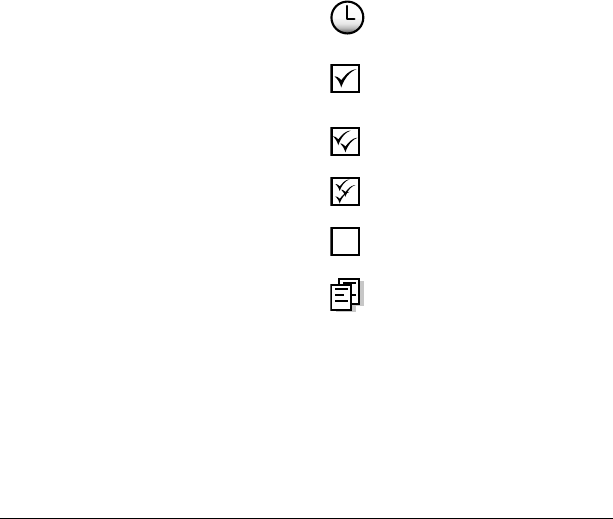
38 Working with messages
When you start a message, the maximum
character limit appears once you are in the
message entry field. This number counts down as
you enter characters, until it reaches 0.
If you continue to enter text after this counter
reaches 0, a message segment may be appended.
When you reach the message size limit, you are
prompted to edit the message or alerted that the
message is being appended.
Note: Not available on all phones. Check with
your service provider.
Incoming calls while creating
messages
If you receive a call while receiving a message you
will receive a notification. You can do the
following:
•Select Ignore to not answer the call. You will
return to the message screen.
•Press the Call key to answer the call. The
message is saved to the Drafts folder.
Complete messages in drafts folder
To continue composing a message in the Drafts
folder:
1. Select Menu > Messaging > Drafts and the
message you wish to complete.
2. Select the message you wish to complete.
3. Select Edit.
4. Complete your message.
5. Select Send.
View messages in sent msgs folder
To view messages in the Sent Msgs folder, select
Menu > Messaging > Sent Msgs.
Your list of saved messages will appear with the
following symbols.
View failed or pending messages
Failed or pending messages are stored in your
Outbox. To view messages in the Outbox, select
Menu > Messaging > Outbox.
The scheduled message will be sent at the
scheduled time. You cannot cancel delivery
of the message.
The scheduled message will be sent at the
scheduled time. You cannot cancel delivery
of the message.
The message has been received.
The message has been received and opened.
The message has been sent to more than one
recipient
The message has never been sent or has not
been sent since it was last modified. You can
cancel delivery of the message.

User Guide 39
Your list of failed or pending messages will
appear with the following symbols.
Message settings
Messaging settings help configure your phones
text and multimedia message settings.
Alerts
Choose your alerts for voicemail, pages, or
messages.
1. Select Menu > Messaging > Msg Settings >
Alerts > Msg Alert, Page Alert, or Voice
Alert.
2. Select an alert.
Note: If you select an alert with an & Remind, the
phone notifies you once when a new message is
received and then notify you again every five
minues. To stop a reminder alert, select Ignore.
Signature
The signature you create is included at the end of
all outgoing messages and is counted as
characters in your messages; however, it does not
appear in the message creation screen.
1. Select Menu > Messaging > Msg Settings >
Signature.
2. Enter your signature in the text field.
3. Select OK to save the signature.
Note: The characters in the signature are
included in the total character count of the
message.
Edit QuickText
Your phone comes with prewritten (QuickText)
messages, such as “Please call me,” which you
can insert into the body of a text message. You can
edit these messages or create new ones. You
phone stores up to 40 QuickText messsages, with
up to 100 characters per message.
1. Select Menu > Messaging > Msg Settings >
Edit Quick Text and one of the following:
–Scroll to a QuickText message and select
Edit.
–Select New Msg to create a new
QuickText message.
2. Enter or edit the text.
3. Select Save.
Note: You can also save a message you have
written or received as QuickText.
The message is pending and will be sent
when possible.
The scheduled message will be sent at the
scheduled time. You cannot cancel delivery
of the message.

40 Message settings
Auto retrieve
To set your phone to auto retrieve multimedia
messages, select Menu > Messaging > Msg
Settings > Auto Retrieve and one of the
following:
•Disable turns off auto retrieve. You will be
prompted before any multimedia messages
are download.
•Enable turns on auto retrieve.
Hide / Show CC/BCC
To show or hide the CC and BCC fields when you
compose a message, select Menu > Messaging >
Msg Settings > Hide CC/BCC or Show CC/BCC.
Callback number
Set a callback number to let recipients know a
number where they can call you back.
1. Select Menu > Messaging > Msg Settings >
Callback Number.
2. Enter number in the text field.
3. Select OK to save the number.
Save to sent
You can save your outgoing messages.
Select Menu > Messaging > Msg Settings >
Save to Sent and one of the following:
•Disabled does not save outgoing messages.
•Prompt allows you to choose whether or not
to save your message when you send it.
•Enabled saves all outgoing messages to the
Sent folder.
Auto-erase
You can set your phone to erase message
automatically when memory is needed for
incoming messages.
Select Menu > Messaging > Msg Settings >
Auto-Erase and one of the following:
•Disabled erases no messages.
•Inbox Msgs erases old messages in your
Inbox when memory is needed.
•Sent Msgs erases old messages in your Sent
folder when memory is needed.
•Both erases old messages in both your Inbox
and Sent folder when memory is needed.
Default text
You can change the default text entry mode when
creating a text message. This setting applies only
to the message body screen, not the “To” screen.
Select Menu > Messaging > Msg Settings >
Default Text and one of the following:
•Normal Alpha enter text in letter by letter.
•Rapid Mode enter text with word recognition.
Message receipts
Request a notification when a recipient has
received a text or multimedia message.

User Guide 41
Select Menu > Messaging > Msg Settings > Text
Msg Receipt or Pict Msg Receipt and one of the
following:
•Don’t Request to not request a notification.
•Request to request a notification.
Voicemail number
Set the number your phone calls to retrieve
voicemail. Often your voicemail number is
automatically programmed by your service
provider.
1. Select Menu > Messaging > Msg Settings >
Voicemail Number.
2. Select Edit.
3. Enter the voicemail number. Use Options >
Time Pause or Hard Pause to enter pauses.
4. Select Save.

42 Menu options
10 SETTINGS
Menu options
The contents of the Settings menu are as follows:
Bluetooth
The Bluetooth® wireless technology on your
phone enables wireless connectivity with
accessories such as portable or installed hands-
free car kits, headsets, handsets, computers, PC
cards and adapters, PDAs, and speakers.
Not available on all phones. For details check with
your service provider.
You must use a Bluetooth device (compatible with
Class 2 Bluetooth wireless technology, version
1.2) in order to use this phone wirelessly.
Bluetooth accessories are noted with a symbol.
Turn Bluetooth on
You must turn on your phone’s Bluetooth feature
to use it with Bluetooth devices.
Bluetooth
On/Off
My Devices
Settings
Sounds
Ringers
Ringer Mode
Volume
Flip Sounds
Pwr On/Off
Keypad
Alerts
Msg Alert
Page Alert
Voicemail Alert
Misssed Call Alert
Display
Wallpaper
Screensaver
Themes
Main Menu View
My Banner
My Ticker
Backlighting
Brightness
Language
Time/Date Format
My Phone
Convenience
Voice Features
Phone Info
Network
Data/Fax Calls
Privacy Alert
Voice Privacy
Data Setup
User Name
Roam/Svc Alert
Roam Option
Set Phone Line
Web Alert
Roam Call Alert
Location
Security
Lock Phone
Limit Calls
Emergency Numbers
Erase Contacts
New Lock Code
Accessories
Headset Sounds
Auto-Answer
Pwr Backlighting
Com Port Speed
Memory Card
TTY Device
Hearing Aid
USB Mode
Music (MTP)
Mass Storage
Modem/COM
Note: Some features are not available on all phones. Check with your service provider.

User Guide 43
Select Menu > Settings > Bluetooth > On/Off
and one of the following:
•On Visible allows other devices to find your
phone.
•On Invisible hides your phone for all devices
except those listed in your My Devices.
•Off prohibits your phone from being used
with any Bluetooth wireless technology device.
To prolong battery life, it is recommended to
turn Bluetooth off when you are not using it.
When you turn Bluetooth on the first time, you
will be prompted to do a device search. You can
immediately pair with a device.
Pairing
You must first “pair” your phone with the
Bluetooth device to allow your phone to
communicate with it. Refer to the instructions for
setting up Bluetooth (below) in conjunction with
the user guide provided with your Bluetooth
device.
1. Select Menu > Settings > Bluetooth > On/
Off > On Visible or On Invisible.
2. Prepare the Bluetooth device or accessory
for pairing as described in the other device’s
user guide.
3. Select Menu > Settings > Bluetooth > My
Devices > Find New.
4. Your phone will search and detect visible
Bluetooth devices in the vicinity.
5. If devices are found, select Add to see the
list.
6. At the device list, highlight a device and
select Add.
When pairing is initiated from another
Bluetooth device, you will be prompted to
accept or reject the pairing.
7. If necessary, enter the password provided in
the Bluetooth device’s user guide and select
OK.
Your phone waits for the device’s response.
If the password is accepted the device is
added to My Devices.
Using Bluetooth
Before you can use the Bluetooth functions of
your phone, you must set your phone to be ready
to communicate with a device. This is called
“connecting.”
Connect to a device
To connect your phone to an audio Bluetooth
device:
1. Select Menu > Settings > Bluetooth > My
Devices.
2. At the device list, highlight a device and
select Connect.
A notification appears confirming the connection.
you can now use the device with your phone.

44 Sounds
Disconnect from a device
To disconnect your phone from an audio
Bluetooth device:
1. Select Menu > Settings > Bluetooth > My
Devices.
2. At the device list, highlight a device and
select Disconnect.
Device list options
You can change or review the information about
each device you paired with your phone.
1. Select Menu > Settings > Bluetooth > My
Devices.
2. At the device list, highlight a device, select
Options and one of the following:
–Rename to rename the device.
–Delete to remove the device from your
phone if you are no longer going to use
it.
–Services to view a description of the
device (such as Headset, Handsfree,
Object Push, and Serial Port).
Bluetooth settings
You have several settings for how your phone
interacts with Bluetooth devices.
Select Menu > Settings > Bluetooth > Settings
and one of the following:
•My Name changes the name of your phone to
identify to other devices it is paired with.
•Visible Duration sets the time your phone
remains visible to other devices.
•Services shows the list of the Bluetooth
protocol supported by your phone.
•OBEX Authentication enables or disables
OBEX authentication.
Sounds
Your phone has several settings that control the
sound. You can pick ringers from a variety and
well and control the volume.
Ringers
You can change the ringer for your phone. You
can also assign ringers for different tasks.
Ringer types
Your phone has multiple ringers you can choose
to use for all incoming calls, incoming business
calls and incoming personal calls.
1. Select Menu > Settings > Sounds >
Ringers > Ringer Type, Business Ringer,
or Personal Ringer.
2. Select a ringer. As you scroll down the list
you will hear the ringers.
Roam ringer
Your phone can alert your to roaming calls with a
specific ringer. Select Menu > Settings > Sounds
> Ringers > Roam Ringer > Enabled.

User Guide 45
Ringer mode
Your phone is set to make sounds when you
receive calls, press keys, navigate through menus,
and receive alerts (such as new messages).
You can silence all sounds and set the phone to
vibrate or light up when you receive calls and
alerts.
Select Menu > Settings > Ringer Mode and one
of the following:
•Normal Sounds rings for the incoming call or
alert (in effect, returns phone to a non-silent
mode).
•Vibrate Only vibrates for the duration of the
incoming call or other alerts.
•Vibe Then Ring vibrates for the first 10
seconds and then rings for the remainder of
the incoming call alert.
•Lights Only lights up for the duration of the
incoming call or other alerts.
You can also press and hold the Space # key to go
back forth from Vibrate Only mode to Normal
Sounds mode.
Note: The phone will ring when it is attached to
an external power source (such as a charger),
even if all sounds have been silenced.
Volume
Control the volume of your phone’s features.
Volume controls
Control the volume of the phone’s ringer,
speakerphone, earpiece and keypad.
1. Select Menu > Settings > Sounds >
Volume > Ringer Volume, Spkrphone
Volume, Earpiece Volume, or Key Volume.
2. Scroll right to increase the volume or left to
decrease the volume.
3. Press the OK key to save
Smart volume
To automatically adjust the volume during a call,
based on surrounding noise levels, select Menu >
Settings > Sounds > Volume > Smart Volume
> Enabled.
Flip sounds
Assign specific sounds for when your phone flip
opens or closes.
1. Select Menu > Settings > Sounds > Flip
Sounds > Flip Open or Flip Closed.
2. Select a sound. As you scroll down the list
you will hear the sounds.
Power on/off sound
You can set your phone to play a sound when
powering on and off. Select Menu > Settings >
Sounds > Pwr On/Off > Enabled.
Keypad
Control the keypad tones of the phone.

46 Alerts
Key sound
To choose the sounds the keys make when
pressed, select Menu > Settings > Sounds >
Keypad > Key Sound > Tone, Click or Off.
Key length
To control the length of the keypad tones, select
Menu > Settings > Sounds > Keypad > Key
Length > Normal or Long.
Alerts
Choose how you want be alerted of Messages,
pages, voicemail and missed calls
1. Select Menu > Settings > Alerts > Msg
Alert, Page Alert, Voicemail Alert, or
Missed Call Alert.
2. Select an alert.
Note: If you select an alert with an & Remind, the
phone notifies you once when a new message is
received and then notify you again every five
minues. To stop a reminder alert, select Ignore.
Display
Wallpaper
You can select a wallpaper for your phone’s home
screen.
1. Select Menu > Settings > Display >
Wallpaper.
2. Select wallpaper choice from one of the
following options:
–Select a wallpaper from the preloaded
list.
–Select Options > Camera Pictures.
–Select Options > Saved Images.
Screensaver
Screensavers appear on the home screen when
the flip is open or closed. A screensaver activates
10 seconds after the last keypress. Incoming calls
and alerts override the screensavers.
1. Select Menu > Settings > Display >
Screensaver.
2. Select screensaver choice from one of the
following options:
–Select a screensaver from the preloaded
list.
–Select Options > Camera Pictures.
–Select Options > Saved Images.
Themes
You can select a color theme for the display
background of your phone.
1. Select Menu > Settings > Display >
Themes.
2. Select a color theme. As you scroll down the
list you will preview the themes.

User Guide 47
Main menu view
Display menus in various formats. Select Menu >
Settings > Display > Main Menu View and one
of the following:
•Graphic displays icons of each menu item,
with its name at the bottom of the screen.
•List displays a list of each menu item.
The next time you select Menu from the home
screen, you see the menu style you selected.
My banner
The banner is the personal label for your phone.
It appears on the home screen above the time and
date. To change your banner:
1. Select Menu > Settings > Display > My
Banner.
2. Select Edit and press the Back key to clear
the current banner.
3. Enter your new text and select Save.
My ticker
The ticker is the personal label for your phone. It
scrolls across the external screen. To change your
ticker:
1. Select Menu > Settings > Display > My
Ticker.
2. Select Options > Edit and press the Back
key to clear the current banner.
3. Enter your new text and select Save.
Backlighting
Your screen lights up while you are in a call or
when you press a key on the keypad. The
backlight automatically turns off when the phone
is inactive.
Set backlight duration
You can set the length of time that bright
backlighting remains on. Select Menu > Settings
> Display > Backlighting > Duration and one
of the following:
•Disabled turns backlighting off.
•7 seconds, 15 seconds, or 30 seconds
(default) turns backlighting on for a set time
after your last keypress.
•7 sec & in call, 15 sec & in call, or 30 sec &
in call turns backlighting on for the duration
of a call, and for a set time after your last
keypress.
Note: The “in call” settings drain the battery
more quickly.
Power save mode
You can conserve batter life by activating power
save mode to dim the backlight. The power save
mode will set the backlight of the phone to the
lowest level. Select Menu > Settings > Display >
Backlighting > Pwr Save Mode > On.

48 My phone
Brightness
Change the brightness of the display.
1. Select Menu > Settings > Display >
Brightness.
2. Scroll to change the brightness.
3. Press the OK key to save.
Language
Your phone can display alternative languages.
Select Menu > Settings > Display > Language
and a language.
Time and date format
Your phone can display different time and date
formats. Select Menu > Settings > Display >
Time/Date Format and a format.
My phone
Convenience
You phone has several setting that may make your
phone more convenient to use.
Airplane mode
While in an airplane, it is normally required that
you turn off your mobile phone because it emits
RF signals that interfere with air traffic control. In
Airplane mode, however, your phone will not emit
RF signals. You cannot make or receive calls,
send text messages, use the browser, or
Bluetooth, but you can play games, use the
Scheduler, set the clock, and make emergency
calls to designated emergency numbers. Please
check with uniformed personnel before operating
your phone in Airplane mode.
To set your phone to Airplane mode, select Menu
> Settings > My Phone > Convenience >
Airplane Mode > OK > Enabled.
If you turn on Airplane mode, you can also set the
time and date manually.
Set Date/Time
While in Airplane Mode, you phone does not keep
time automatically. You can set the time and date
manually.
1. Select Menu > Settings > My Phone >
Convenience > Set Date/Time.
2. At the Date field, modify the date. Press OK
to change the date.
–Scroll left or right to move between
month, day and year fields.
–Scroll up or down to change month, day
and year.
Press the OK key to save date and move to
the next field.
3. At the Time field, modify the time. Press OK
to change the time.
–Scroll left or right to move between hour,
minute and AM/PM fields.
–Scroll up or down to change hour,
minute and AM/PM.
Press the OK key to save time and move to
the next field.

User Guide 49
4. Select Done.
Auto-Hyphen
Auto-hyphenation, when enabled, automatically
inserts hyphens into your phone numbers to be
consistent with the U.S. dialing plan. For example,
1-222-333-4444. To turn on, select Menu >
Settings > My Phone > Convenience > Auto-
Hyphen > Enabled.
1-Touch dialing
The 1-Touch Dialing feature is the fastest way to
call a speed dial location. To call a contact with
speed dial, press and hold the speed dialing
location.
To use 1-Touch dialing, you must enable 1-Touch
dialing on your phone and have a speed dial
location assigned to a contact.
To enable 1-touch dialing, select Menu >
Settings > My Phone > Convenience > 1-Touch
Dialing > Enabled.
Auto redial
Auto redial, when enabled, allows you to
automatically redial outgoing calls. Select Menu
> Settings > My Phone > Convenience > Auto
Redial > Enabled.
Hold calls
The Hold Call feature allows you to place
incoming calls on hold until you are ready to
answer them.
Note: The Hold Call feature will not work if the
Open to Answer feature is enabled. See “Open to
answer” on page 50.
Enable hold call feature
1. Select Menu > Settings > My Phone >
Convenience > Hold Call > Enabled.
If you have not recorded a hold message, you
will be prompted to record one, such as
“Please hold. I’ll answer in a minute.”
2. Record the message twice, as prompted.
3. Select Save to save the message or Options
and one of the following:
–Play to replay your message.
–Re-Record to record your message
again.
–Exit to exit.
The next time a call comes in, you will have the
option of placing it on hold.
Place a call on hold
You can place a call on hold once you have
enabled this feature.
Note: If you are already on a call and you receive
another call, you cannot place the incoming call
on hold. It will go to voicemail.
When a call comes in, do the following:
1. Select Hold Call. The caller will be placed
on hold and will hear your recorded hold
message.

50 My phone
2. Select Answer to speak to the caller on hold
or End Call to hang up without speaking.
Change the hold message
1. Select Menu > Settings > My Phone >
Convenience > Hold Call > Re-Record
Msg.
2. Record the message twice, as prompted.
3. Select Save to save the message or Options
and one of the following:
–Play to replay your message.
–Re-Record to record your message
again.
–Exit to exit.
Fast find
With Fast Find enabled, you can press one or two
keys to view close matches of the number you are
looking for.
1. From the home screen, press the keys
corresponding to the letters of the name you
want to find. A matching contact or speed
dial entry appears.
2. Scroll to the contact you want and press the
Call key to call the number.
To enable Fast Find, select Menu > Settings > My
Phone > Convenience > Fast Find > Enabled.
Frequent list
From the home screen, select Contacts. The last
15 contacts of you most frequently called contacts
appear when the Frequent List is enabled. Scroll
past the double line to view the entire Contacts
directory.
To enable Frequent List, select Menu > Settings
> My Phone > Convenience > Frequent List >
Enabled.
Minute alert
Your phone can alert with a short beep ten
seconds before each minute passes during a call.
Select Menu > Settings > My Phone >
Convenience > Minute Alert > Enabled.
Open to answer
Open to answer allows you to answer a call by
opening the flip.
Select Menu > Settings > My Phone >
Convenience > Open to Answer > Enabled.
Voice features
Following features allow you to customize the
voice commands.
Automatic add
You can set the phone to automatically add a
contact to your voice dial list when you create a
new contact.
Select Menu > Settings > My Phone > Voice
Features > Automatic Add > Enabled.
Expert mode
When expert mode is enabled, instead of speaking
a command following the initial voice prompts,

User Guide 51
you can speak the command after you hear a
tone.
Select Menu > Settings > My Phone > Voice
Features > Expert Mode and one of the
following:
•Normal sets phone to default voice prompts.
•Expert sets phone to sound tones instead of
voice prompts.
Display results
You can set the phone to display up to three
recognition contacts when calling or searching
for a contact with voice commands.
Select Menu > Settings > My Phone > Voice
Features > Display Results > Single Best or
Three Best.
Digit lengths
You can set the number of digits used for a phone
number in your voice dial list.
Select Menu > Settings > My Phone > Voice
Features > Digit Lengths and one of the
following:
•North American allows 7, 10, and 1 + 10
digits in a phone number.
•Permit All allows 4-14 digits in a phone
number.
Voice answer
You can set your phone to answer a call
automatically when using a hands-free.
Enable voice answer
Select Menu > Settings > My Phone > Voice
Features > Voice Answer > With Accessory.
To use the voice answer feature, you must disable
the Auto-Answer feature (see “Auto-answer” on
page 56) and set the phone to normal sounds
(see “Ringer mode” on page 45).
Use voice answer
When you receive an incoming call, the phone
prompts you with a voice recording. If the caller
is recognized as a contact entry in your phone,
then the phone prompts “Incoming call from
(Name), answer?”
Say “Yes” or press any key except the End key to
answer.
Say “No” and press the End key to silence the
alert. Remain silent. The voice alert repeats twice
and the phone rings once, then returns to the
home screen.
Voice wake-up
You can set your phone to make a call using a
hands-free.
Enable voice wake-up
Select Menu > Settings > My Phone > Voice
Features > Voice Wake-Up > With Accessory.
Use voice wake-up
To wake up the phone:
1. Say “Wake Up” and listen for a tone.

52 Network
2. Say “Wake Up” again until you hear two
tones.
If the phone does not recognize your Wake Up
command, see “Voice training” on page 52.
Voice training
If you phone is having trouble recognizing your
voice, you can train by speaking number
commands.
1. Select Menu > Settings > My Phone >
Voice Features > Voice Training.
2. Read the message and select OK.
3. Select Train Numbers.
4. Read the message and select OK.
5. Follow the prompts displayed on the screen.
Speak each number until training is
complete.
To untrain your phone select Select Menu >
Settings > My Phone > Voice Features > Voice
Training > OK > Untrain Numbers.
Phone information
You can access informtion regarding your phone.
Select Menu > Settings > My Phone > Phone
Info and one of the following:
•Build Info shows specific software and
hardware information.
•Icon Key shows the icons used by your
phone.
Network
Data and Fax Calls
Your phone may be able to receive certain data or
faxes, depending on the system sending the
information. You cannot receive voice calls while
the phone is in data/fax mode.
To receive data or faxes, you must connect the
phone to a laptop or PC and switch the phone
from voice mode to data/fax mode.
Note: To purchase a cable, visit www.kyocera-
wireless.com/store.
To enable data/fax mode, select Menu > Settings
> Network > Data/Fax Calls and of the
following:
•Voice Only turns data/fax mode off.
•Fax, next call or Data, next call sets the
phone to data/fax mode for the next incoming
call or the next ten minutes.
•Fax, until off or Data, until off sets the
phone to data/fax mode until the phone is
turned off.
Privacy Alert
You set your phone to alert you when enhanced
digital CDMA privacy is lost or regained. Select
Menu > Settings > Network > Privacy Alert >
Enabled.

User Guide 53
Voice Privacy
Set your phone to use enhanced digital CDMA
privacy. Select Menu > Settings > Network >
Voice Privacy > Enhanced.
Data Setup
Set your phone’s connection type for data
applications.
Select Menu > Settings > Network > Data Setup
and one of the following:
•Automatic select the best connection type
based on your service.
•QNC Only allows only standard circuit-
switched calls.
•1XRTT Only allows the use of high-speed
packet data.
User Name
Allows you to set a user name and password if
your phone is data enabled.
1. Select Menu > Settings > Network > User
Name.
2. Enter or modify your user name. Select Next.
3. Enter or modify your password. Select Done.
Roaming Service Alert
Use this setting if you want the phone to alert you
when you roam outside of your home service
area.
Select Menu > Settings > Network > Roam/Svc
Alert and one of the following:
•Disabled turns roaming service alert off.
•When no svc alerts you with three tones
decreasing in pitch when service is lost and
three tones increasing in pitch when service is
acquired again.
•On roam change alerts you with two
decreasing tones when roaming service is
acquired and three increasing tones when
home area service is acquired again.
•On any change alerts you with three
increasing tones if there is a change in
roaming service or three decreasing tones if
the phone loses service.
Roam Option
You can restrict your phone from making a call
when roaming. Select Menu > Settings >
Network > Roam Option > Automatic (allows
roaming) or No Roaming (disallows roaming).
Set Phone Line
Your phone can have two service accounts, or
phone lines, associated with it. Each phone line
has its own phone number. Select Menu >
Settings > Network > Set Phone Line and a
phone line.
When you are using one line, you cannot receive
calls from the other. It would be as if the phone
were “off” for that number. Your voicemail,

54 Security
however, will still take messages. All contacts and
settings are shared for both lines.
Note: You must first establish a second phone
line with your service provider. Once established,
a second phone number becomes available in the
menu for selection.
Web Alert
You can set an alert to confirm the start or exit of
the browser.
Select Menu > Settings > Network > Web Alert
and one of the following:
•At Start prompts when you start a session.
•At End prompts when you end a session.
•Both prompts when you start and end a
session.
•No Prompts for no prompts.
Roam Call Alert
You can set the phone to warn you before you
answer or place a call while roaming. Select
Menu > Settings > Network > Roam Call Alert
> Call Prompt.
The phone emits a distinctive ring to indicate
when you are roaming during a call. To accept or
place a call while roaming, you must press 1.
Note: Call prompt is disabled when the phone is
in Emergency Mode.
Location
This setting allows you to share your location
information with network services other than
emergency services (for example, 911, 111, 999
and 000) in markets where service has been
implemented
This feature works only when your phone is in
digital mode. You do have the option of turning of
the locator to emergency services.
Select Menu > Settings > Network > Location
and one of the following:
•911 Only (default) shares your position
information only with emergency services
when you call your 3-digit emergency code.
•Location On shares your position
information, in addition to emergency
services.
Security
This section describes all the features involved in
securing your phone and preventing access to
personal information. All security features are
shielded by a four-digit lock code.
Lock Phone
When your phone is locked, you can call only
emergency numbers or your service provider’s
customer service number. You can still receive
incoming calls.
1. Select Menu > Settings > Security.
2. Enter your four-digit lock code.

User Guide 55
3. Select Lock Phone and one of the following:
–Never leaves the phone always unlocked.
–On power up locks the phone every time
you turn it on.
–Now locks the phone immediately.
Do the following to unlock the phone:
1. From the home screen, select Unlock.
2. Enter your four-digit lock code.
Limit Calls
You can limit the calls that can be made from your
phone to emergency numbers, your contacts, and
your service provider’s numbers.
1. Select Menu > Settings > Security.
2. Enter your four-digit lock code.
3. Select Limit Calls and one of the following:
–No Limit does not limit call.
–Limit Outgoing limits outgoing calls.
Incoming calls can be answered.
–Limit All limits both incoming and
outgoing calls.
Emergency Numbers
The emergency numbers feature allows you to
specify three personal phone numbers that can be
called when the phone is locked.
1. Select Menu > Settings > Security.
2. Enter your four-digit lock code.
3. Select Emergency Numbers.
4. Select an Unassigned slot.
5. Enter the number and select Done.
You can view these numbers only when they’re
being entered for the first time.
To make a call to an emergency number from a
locked phone, you must dial the number
(including area code) exactly as it was stored in
Emergency Numbers.
Erase Contacts
You can erase all entries from your Contacts
directory.
1. Select Menu > Settings > Security.
2. Enter your four-digit lock code.
3. Select Erase Contacts and one of the
following:
–No exits without erasing contacts.
–Yes erase all contacts. A confirmation
prompt appears to verify your decision.
4. Select Yes to confirm.
New Lock Code
Change your lock code from the default provided
by the service provider. The lock code is typically
0000 or the last 4 digits of your phone number.
1. Select Menu > Settings > Security.
2. Enter your four-digit lock code.
3. Select Lock Code.
4. A confirmation prompt appears. Select Yes.
5. Enter a new four-digit code
6. Re-enter your new lock code

56 Accessories
The lock is now changed
Accessories
This section describes settings that affect
accessories you use with your phone.
Headset sounds
When a headset is attached to your phone, the
ringer can be played through the headset or
phone speaker.
Select Menu > Settings > Accessories >
Headset Ringing and one of the following:
•Out of phone rings from the phone speaker.
•Out of headset rings from the headset.
Auto-answer
When a headset or hands-free kit is attached to
your phone, the phone can be set to answer
automatically.
To turn auto answer on, Select Menu > Settings
> Accessories > Auto-Answer > After 5
Seconds. It will automatically answer after 5
seconds.
Power backlighting
You can set backlighting to remain on when an
external power source, such as the AC adapter, is
used with the phone.
Note: Power backlighting may not be available
with the optional desktop charger or other
accessories.
Select Menu > Settings > Accessories > Pwr
Backlighting and one of the following:
•Normal sets power backlighting to normal.
•Always On keeps power backlighting when an
accessory.
Tip: Use the power backlighting as a night light
when traveling.
Com port speed
The Com Speed sets the data rate at which your
phone connects to a laptop or PC. Select Settings
> Accessories > Com Port Speed and a speed.
There may be a higher charge for making calls
using high-speed data in areas where 1X service is
available. Check with your service provider for
details.
Memory card
A memory card extends the phone memory. Files
on the memory card will appear in the media
gallery, see “Media Gallery” on page 29.
Select Menu > Settings > Accessories >
Memory Card and one of the following:
•Items to Save selects the file types that can
viewed, moved or copied.
•Format Card formats the memory card, so it
can used with the phone.
Note: An icon notes files saved on the memory
card.

User Guide 57
TTY device
You can connect the phone to a teletype (TTY)
device for the hearing impaired.
Note: Enable TTY only when using the phone with
a TTY device.
1. Connect the TTY device to the phone.
2. Enter ##889 with your keypad and select
TTY.
or, select Menu > Settings > Accessories >
TTY Device.
3. At the notification, select OK.
4. Select TTY On to connect or TTY Off to not
connect.
Hearing aid
You can use your phone with a T-coil hearing aid
device. Select Menu > Settings > Accessories >
Hearing Aid > OK > Enabled.
Note: Enable Hearing Aid only when using the
phone with a T-coil hearing aid device.
USB mode
Set how your phone connects to a USB device.
Select Menu > Settings > USB Mode and one of
the following:
•Music (MTP) allows the phone to be
recognized as a music device.
•Mass Storage allows the phone to be
recognized as a mass storage device.
•Modem/COM allows the phone to be
recognized as a modem and com port.

58 Voice memo
11 TOOLS
Your phone comes with tools and games. Some of
the games or tools described here may not be
available on your phone.
If you receive and incoming call while you are
playing a game, the game is paused and exited.
You can return to play once the call alert ends.
Games do not remain paused if the phone is
turned off or loses power.
Voice memo
The Voice Memo tool allows you to record and
play back audio memos.
Record voice memos
To record new voice memos, do the following:
1. Select Menu > Tools > Voice Memo >
Record New.
2. Say your voice memo. Select Stop when you
are done.
3. Select Save to save your memo.
If an incoming call is received while you are
recording a memo, the memo is saved and the
incoming call screen appears.
Review voice memos
To play and use voice memos, do the following:
1. Select Menu > Tools > Voice Memo >
Recorded Memos.
2. At the file list, highlight a file.
3. Select Send to create a message with the
memo attached or select Options and one of
the following:
–Play plays the memo.
–Record New records a new voice memo.
–Erase deletes the memo.
–Send to Online uploads a file to an
online server.
–Lock / Unlock prevents accidental
erasing of the sound.
–Rename renames the sound.
–Details displays the details of the file.
–Erase All deletes all memos stored.
Scheduler
The Scheduler allows you to schedule events and
set reminder alerts.
Create an event
1. Select Menu > Tools > Scheduler > Add
New Event.
2. At the Event Name field, enter a name. Scroll
down to move to the next field when done.
3. At the Type field, choose an event. Press the
OK key and select a choice from the list.

User Guide 59
4. At the Date field, modify the date, if needed.
Press OK to change the date.
–Scroll left or right to move between
month, day and year fields.
–Scroll up or down to change month, day
and year.
Press the OK key to save date and move to
the next field.
5. At the Time field, modify the time, if needed.
Press OK to change the time.
–Scroll left or right to move between hour,
minute and AM/PM fields.
–Scroll up or down to change hour,
minute and AM/PM.
Press the OK key to save time and move to
the next field.
6. At the Duration field, modify the duration of
event, if needed. Press OK to change the
duration.
–Scroll left or right to move between hour
and minute fields.
–Scroll up or down to change hour and
minute.
Press the OK key to save duration and move
to the next field.
7. At the Priority field, choose a priority. Press
the OK key and select a choice from the list.
8. At the Reminder field, choose a reminder.
Press the OK key and select a choice from
the list.
9. At the Silent Mode field, press the OK key
and select No to leave on normal sounds or
During Event to place phone in silent mode
during the duration of the event.
10. At the Recurring Event field, make the event
recurring, if need. Press the OK key and
select a choice from the list.
11. Select Save to save the event.
View events
You can view the events saved to the scheduler.
View by date
1. Select Menu > Tools > Scheduler and one
of the following:
–View Month displays the current month.
Days with events are highlighted. Scroll
through the calendar. Press the OK key to
select a date.
–View Day displays the current date.
Scroll right or left to move to another
date.
–Go to Date chooses a specific date.
Scroll left or right to move between
month, day and year fields. Scroll up or
down to change month, day and year.
Press OK to select the date.
2. At the day view, do one of the following:
–Select an existing event to view the event
detail.

60 Alarm clock
–Scroll to a time and select Add New to
create a new event.
–Options > Go to Today returns to the
current date.
–Options > Go to Date selects a specific
date.
–Options > Erase Today’s Events deletes
all event for that date.
View by list
1. Select Menu > Tools > Scheduler > View
All Events.
2. At the event list, select one of the following:
–Scroll to an event and select View tp
display the event detail.
–Options > Sort by Time sorts events by
time.
–Options > Sort by Type sorts events by
type.
–Options > Sort by Priority sorts events
by priority.
–Options > Erase All Events deletes all
events.
Modify an event
You can modify existing events.
From the event detail screen, you can select OK to
return to the previous screen or Options and one
the following:
•Edit edits the event.
•Erase deletes the event.
•Send creates a message containing the event.
•Copy create a event with the existing event
information.
Scheduler settings
You can change the default settings of your
scheduler.
Select Menu > Tools > Scheduler > Settings
and one the following:
•Scheduler Hours changes the work day.
•Auto Delete deletes events automatically.
•Priority priorizes new events.
•Reminder assigns reminders for new events.
•Reminder Sound assigns sound alerts for
new event reminders.
•Silent Mode sets phone to silent mode for
new events.
Alarm clock
You can set up to four alerts with your phone’s
three alarm clocks and one quick alarm.
Note: The alert occurs only if the phone is on.
Set the alarm clocks
1. Select Menu > Tools > Alarm Clock.
2. Scroll to one of the alarms and select Set.
3. At the Time field, modify the time, if needed.
Press OK to change the time.
–Scroll left or right to move between hour,
minute and AM/PM fields.

User Guide 61
–Scroll up or down to change hour,
minute and AM/PM.
Press the OK key to save time and move to
the next field.
4. At the Alarm Sound field, choose a sound.
Press the OK key and select a choice from
the list.
5. At the Recurring Alarm field, make the alarm
recurring, if needed. Press the OK key and
select a choice from the list.
6. At the Note field, enter a note. Press the OK
key.
7. Select Save to set the alarm(s).
When the alarm rings, select Off to turn off the
alarm or Snooze to silence the for 10 minutes.
Tip: Opening the flip turns off the alarm.
Set the quick alarm
1. Select Menu > Tools > Alarm Clock.
2. Highlight the quick alarm and select Set.
3. At the Time field, select a time option. A
notification shows the quick alarm is on.
When the quick alarm rings, select Off to turn off
the alarm or Reset to set the quick alarm again.
Tip calculator
The Tip Calculator helps you calculate how much
tip to include with a bill.
1. Select Menu > Tools > Tip Calculator.
2. Enter the amount of your bill and select
Next.
3. Select the percentage amount to tip. The new
bill amount is shown.
4. Select Done to return to menu or Split to
split the bill.
To split the bill enter number of guests and
select Next. The new bill amount with splits
is shown. Select Done to return to menu.
Calculator
The Calculator can perform basic mathematical
operations.
1. Select Menu > Tools > Calculator.
2. Enter the first number.
3. Select a mathematical operation:
–Scroll left to multiply
–Scroll right to divide
–Scroll up to add
–Scroll down to subtract
The chosen operation is highlighted.
4. Enter the second number. Press the OK key
to perform the operation. The result is
shown.
5. Select Exit to return to menu or Options and
one of the following:
–M+ adds displayed result to the value
stored in memory.
–MR displays currently stored value on the
screen.

62 Timer
–MC clears value currently stored in
memory.
Timer
The Timer counts down for the specified time. It
beeps when that amount of time has elapsed.
1. Select Menu > Tools > Timer > Set.
2. At the Set Timer, enter the time length.
–Scroll left or right to move between
hours, minutes and seconds fields.
–Scroll up or down to change hours,
minutes and seconds.
3. If need, select Sound and one of the sounds
to change the sound.
4. To work the timer, select the following
options:
–Start begins the countdown.
–Stop pauses the countdown.
–Reset clears the timer.
When the countdown is complete select Off to
silence the alarm.
Stopwatch
The Stopwatch counts time for you.
1. Select Menu > Tools > Stopwatch.
2. To work the stopwatch, select the following
options:
–Start begins counting.
–Stop pauses counting.
–Reset clears the stopwatch.
Press the Back key to return to the menu.
Memopad
Write memos on your phone.
Write memos
To write a memo select Menu > Tools >
Memopad > New Memo.
Use memos
To use memos:
1. Select Menu > Tools > Memopad > View
Memos.
2. From the memo list, select a memo.
3. Select Options and one of the following:
–Edit modify the memo.
–Send as SMS sends memo as text
message.
–Use Number uses a number in the
memo.
–Lock Memo / Unlock Memo prevents
accidental erasing of the memo.
–Erase deletes the memo.
–Erase All deletes all the memos.
World clock
The world clock lets you check times in cities
around the world in relation to local time.

User Guide 63
Set the world clock
1. Select Menu > Tools > World Clock.
The world clock menu is displayed. Your
local time and date is on the first line,
followed by your selected world city and that
city’s time and date.
2. When you first access World Clock, scroll left
or right to select a time zone.
The world clock menu is displayed again, with
Athens time and date.
Search the world clock
From the world clock menu, you can search by
city or country.
1. Select Menu > Tools > World Clock >
Options > Search City or Search Country.
2. In the search field, enter letter(s) to search
by. Results are listed as you type.
3. Select a city or country from the list.

64 Launch Web browser
12 BROWSER
You can use your phone to browse the Internet if
you have obtained phone Internet services from
your service provider and if over-the-air Internet
access is available in your area.
Note: You cannot receive incoming calls while
you are using the browser.
Launch Web browser
1. Select Menu > Browser.
A message about airtime fees appears every
time you start the browser.
For more information about how airtime is
charged, contact your service provider.
2. Select OK to continue.
If this is the first time you have connected to
the Internet, a message informs you that
security is not yet enabled for your browser.
3. Select Yes to enable security.
When you are connected, a browser home
page appears. It has a list of bookmarks and
some browser menu options at the bottom of
the screen.
The lock icon appears in a secure session.
An underline and an arrow indicate that
there is more text. Scroll down to view more
text. Press the Back key to return to the
previous screen.
4. To choose a site, scroll to the link and select
Go.
5. When you have finished using the browser,
press the End key to exit.
Use browser options
The following options may appear during a
browser session.
•Home returns you to the main browser
window, or home page.
•Mark Site saves the current location as a
bookmark for easy access.
•Bookmarks displays a list of your saved Web
sites.
•Setup gives you options for changing how
information is displayed.
–Show URL displays the entire URL.
–About Openwave displays information
about your browser version.
–Encryption should not be used unless you
are instructed to do so by your service
provider.
–UP.Link selects a different browser server.
You can use this option if you have more
than one browser account.
–Restart restarts the browser.

User Guide 65
Search for a Web site
How you search for a Web site depends on your
service provider. For more information, contact
your service provider.
Use a bookmark
1. Select Menu > Browser.
2. Select OK to accept browser fees.
3. From your Web home page, select
Bookmarks. A list of bookmarks appears.
4. Enter the number corresponding to the
bookmark you want and press the OK key.
Check browser alerts
Alerts received from a Web site are sent to your
Browser Alerts folder. To check them, do the
following:
1. Select Menu > Messaging > Browser
Alerts. This action launches the browser
inbox.
2. Select OK to accept browser fees.
3. Select an alert and follow the prompts.
Set a Web prompt
You can set a prompt to confirm the start or exit
of the browser. For more information, see “Web
Alert” on page 54.

66 How does BREW work?
13 DOWNLOADS
Your Kyocera phone has the added ability to
download and manage applications through
BREW.
BREW brings you the full range of applications
and services you have come to expect from the
Internet: Email and instant messaging, real-time
navigation services, group chat, games, relevant
news, and much more.
For more information about BREW capabilities
and application pricing, contact your service
provider.
How does BREW work?
You connect to the server, download applications,
and then manage them as you like. When you
choose an application, you have the option of
choosing a demo, various limited use options, or
the full version—all varying in price. If you
choose a demo, BREW lets you know when it has
expired. If you choose a priced version, the
amount is added to your phone bill. BREW also
lets you know if you’re running out of memory. At
that point, you can either disable an application
or remove it completely.
Once applications are loaded, you can update to
newer versions as they become available.
Download an application
1. From the home screen, select Menu >
Downloads > Mobileshop > Catalog.
When a connection is made, a list of
application types appears.
2. Select an application type. A list of
applications appears. Long titles scroll left as
you highlight them.
3. Select an application. A list of usages
appears. There may be one or more usages
available. Prices are specified for each
usage.
4. Select a usage for the application. You are
prompted to confirm your purchase.
5. Select Yes to confirm. The application
downloads to your phone. Download times
may vary.
To open the application now, select Yes. If you
select No, you return to the Downloads menu,
where you see a link to your new application.
Note: Your connection to the application server
automatically ends after 30 seconds, unless you
connect again to download more apps. If you
want to end the connection manually, press the
End key on your phone.
Open an application
Downloaded applications are stored under the Downloads menu. Each application comes with its
own unique icon, to help you identify it easily.

User Guide 67
From the home screen, select Menu >
Downloads and the application.
1. From the home screen, select Menu >
Downloads.
2. Select an application from the list.
Note: The Downloads icon always remains at the
top of this menu. Downloaded applications are
listed after.
View application details
You can get information about the size of an
application and how many uses it has left before it
runs out.
1. From the home screen, select Menu >
Downloads > Settings > Manage Apps.
2. Select an application to view its details.
Remove an application
If you remove an application, it is removed
completely from your phone. If you want to use it
again, you must pay for it again. If you want to free
up space on your phone, we recommend you
disable the application.
1. From the home screen, select Menu >
Downloads > Settings > Manage Apps.
2. Select an application.
3. Select Remove. At the prompt, select Yes to
confirm.
Disable an application
If you are running out of memory and would like
to download more applications, but do not want
to completely remove those you have paid for, you
can simply disable them. This means you have to
re-download an application in order to use it
again, but don’t have to pay for it again.
1. From the home screen, select Menu >
Downloads > Settings > Manage Apps.
2. Select an application.
3. Select Lock App. At the prompt, select Yes to
confirm.
Note: The application is listed in the Downloads
menu. The icon looks like an empty box.
Check available memory
The amount of memory depends on the number
of applications you download.
From the home screen, select Menu >
Downloads > Settings > Manage Apps >
System Info.
The amount of memory left is shown.
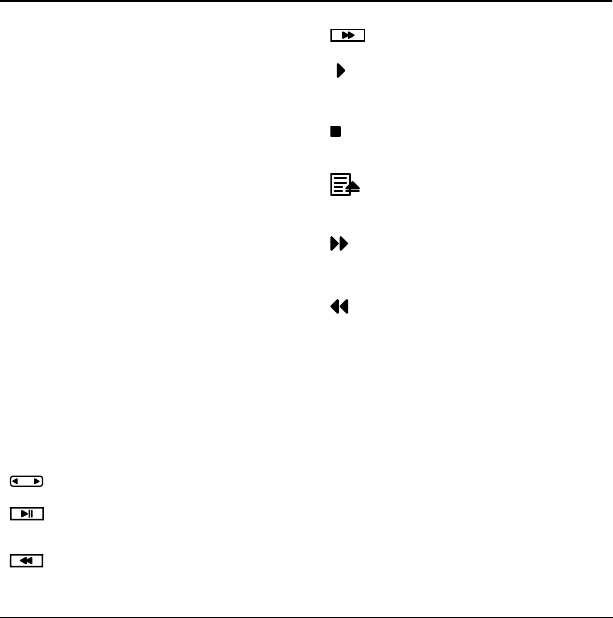
68 Use music player
14 MUSIC PLAYER
Use your phone’s music player to listen to your
favorite songs. Copy music files from your
computer to your phone for your own portable
music player.
Use music player
Play songs
1. Access your phone’s music player in one of
the following ways:
–Press the Play key on the front of your
phone.
–Select Menu > Music Player.
–Select Menu > Media Gallery > Sounds
> Music > All Songs.
2. At the song list, scroll to a song and select
Play.
Music Player keys
Your phone’s music player responds to two
different types of keys. The hard keys on the front
cover and the softkeys on the display screen.
Music Player options
While playing a song, you can select Options and
one of the following:
•Music Library returns to the current playlist.
•Repeat Track On / Repeat Track Off repeats
the song in a loop.
•Minimize shows the Music Player as an icon.
To restore, press and hold the OK key.
•Settings > Repeat plays the current playlist in
a loop.
Volume key. Turn the volume up or down.
Play/Pause key. Start, pause or continue the
song.
Rewind key. Select the previous song.
Fast Forward key. Select the next song.
Play softkey. Start, pause or continue the file.
At the Now Playing screen, press the OK key
as a shortcut.
Stop softkey. Stop the playback. At the Now
Playing screen, scroll down as a shortcut.
Playlist softkey. Show the current playlist. At
the Now Playing screen, scroll up as a
shortcut.
Fast Forward softkey. Select the next song. At
the Now Playing screen, scroll right as a
shortcut.
Rewind softkey. Select the previous song. At
the Now Playing screen, scroll left as a
shortcut.

User Guide 69
•Settings > Shuffle plays the current playlist in
random order.
•Settings > Do Not Disturb turns off all phone
alerts.
•Settings > Equalizer adjusts the equalizer.
•Settings > Visualization turns on visual
effects.
•Settings > Auto Off sets when the music
player automatically stops.
•Settings > Auto Filtration sets how the music
player organizes new files.
•Settings > BT Headset opens the Bluetooth
connection screen.
•Details shows the details of the song.
Load music
Music files can be loaded onto your phone via the
browser or a mulitmedia message. You can also
use the following steps to load music on your
phone:
1. Select Menu > Settings > USB Mode >
Mass Storage.
2. Connect the microUSB cable to the
MicroUSB jack on your phone.
3. Connect the microUSB cable to the USB port
on your computer.
Note: Your computer will not recognize your
phone as a Mass Storage Device unless your
phone is set to Mass Storage mode.
4. On your computer, double-click My
Computer. You will see your phone as a
removable disk drive.
5. Double-click on the removable disk drive.
6. Double-click on the Music folder.
7. Drag and drop music files to the Music
folder.
8. When you are done transferring files,
disconnect your phone from the computer.
Playlists
Create a playlist
1. Select Menu > Media Gallery > Sounds >
Music > Playlists > Options > Create New.
2. Enter a name for the playlist and select Save.
3. At the Add Tracks screen, choose a category
and select OK.
4. At the selection screen, choose a song and
select Mark. Repeat until you select all the
tracks you want.
5. Select Done, when complete. The playlist is
now saved.
Access a playlist
1. Select Menu > Media Gallery > Sounds >
Music > Playlists.
2. Choose a playlist and select Play.

70 Playlists
Modify a playlist
1. Select Menu > Media Gallery > Sounds >
Music > Playlists.
2. Choose a playlist, select Options and one of
the following:
–View opens the playlist.
–Remove Tracks deletes songs.
–Rearrange Tracks reorders the playlist.
–Rename changes the playlist name.
–Erase deletes the playlist.
–Details shows how many songs are on
the playlist.
To modify a song, see “Browse sounds” on
page 30.

User Guide 71
15 VOICE COMMANDS
Voice command feature allows you to use voice
commands to call a contact, dial a phone number,
access menus, or find contact information from
your voice dial list.
Note: You cannot use voice recognition to end a
call; you must press the End key when the flip is
open.
Voice dial list
To call or find a contact using voice dial you must
add the contact to your voice dial list. The contact
name must not have more than three words or
components in a contact name for voice dialing
recognition.
Add contacts
To add a contact to your voice dial list:
1. Select Menu > Contacts > Voice Dial List.
2. At the contact list, highlight a contact and
press the OK key. A checkmark appears next
to a name when voice dialing is active.
Check each name you wish use with voice
dialing.
3. Select Save.
Remove contacts
To add a contact to your voice dial list:
1. Select Menu > Contacts > Voice Dial List.
2. At the contact list, highlight a checkmarked
contact and press the OK key. No checkmark
appears next to a name when voice dialing is
inactive.
Uncheck each name you wish remove from
voice dialing.
3. Select Save.
Voice commands
Start voice commands
1. Press the Call key to initiate voice
commands. The phone prompts, “Say a
commands”.
2. Say one of the following commands and
following the voice prompts.
–“Contact <name>” call to a contact on
your voice dial list.
–“Dial Number <number>” call by
speaking the digits of the phone number.
–“<shortcut name>” sends you to a
menu item.
–“Play” play a playlist with the music
player.
–“Find Contact” allows you to find a
contact from your voice dial list.

72 Voice commands
Call a contact
1. If you haven’t already done so, add the
person you wish to call to the Voice Dial List.
See “Voice dial list” on page 71.
2. From the home screen, press the Call key.
The phone prompts, “Say a command”.
3. Say “Contact” and then name of the person
you want to call.
The phone prompts, “Please repeat” or “Say
a name” if it does not recognize the name. If
the name you spoke matches a contact in the
Voice Dial List, the phone prompts: “Name,
correct?” Say “Yes” to make the call, “No” to
select a similar name, or “Cancel” to cancel
the phone call.
If the phone finds multiple voice tags that
sound like the name you said, the phone will
list the names, you will be asked to verify
which name you want to call. Say “Yes” when
you hear the correct name. Say “No” when
you hear an incorrect name.
4. Press the End key to end the call.
Call a number
1. From the home screen, press the Call key.
The phone prompts, “Say a command”.
2. Say “Dial Number” and then speak the digits
of the number you want to call.
If you pause, the phone prompts you, “Did
you say <number>” or “Say a number” if it
does not recognize the name. Say “Yes” to
make the call, “No” to cancel the phone call.
3. Press the End key to end the call.
Use shortcuts
1. From the home screen, press the Call key.
The phone prompts, “Say a command”.
2. Say the name of the menu item you want to
access or say “Shortcut” to view a list of
menu items. The phone prompts, “Say one of
the shortcuts”.
3. Say the name of the menu item you want to
access.
Tip: Press and hold the Call key to access the
voice shortcuts list quickly.
Play
1. From the home screen, press the Call key.
The phone prompts, “Say a command”.
2. Say “Play” and then say a play list name.
If you pause, the phone prompts you to say a
playlist name.
3. Say “Yes” to confirm your choice.
Find contacts
You can use voice commands to find contact
information for contact’s that are in your voice
dial list. see...
1. From the home screen, press the Call key.
The phone prompts, “Say a commands”.

User Guide 73
2. Say “Find Contacts”. The phone prompts,
“Say a name”.
The phone prompts, “Please repeat” or “Say
a name” if it does not recognize the name. If
the name you spoke matches a contact in the
Voice Dial List, the phone prompts: “Name,
correct?” Say “Yes” to make the call, “No” to
select a similar name, or “Cancel” to cancel
the search.
Voice command settings
You can control settings for your phone’s voice
recognition feature. For more information, see:
•“Automatic add” on page 50
•“Expert mode” on page 50
•“Display results” on page 51
•“Digit lengths” on page 51
•“Voice training” on page 52
Hands-free car kits
You can use voice commands to make a phone
call or to answer the phone only if your phone is
connected to a professionally installed Kyocera
hands-free car kit (sold separately).
The following features apply only to installed
hands-free car kits unless noted.
•“Voice answer” on page 51
•“Voice wake-up” on page 51
•“Auto-answer” on page 56
To shop for hands-free car kits, visit
www.kyocera-wireless.com/store or call
800-349-4188 (U.S.A. only) or 858-882-1410.
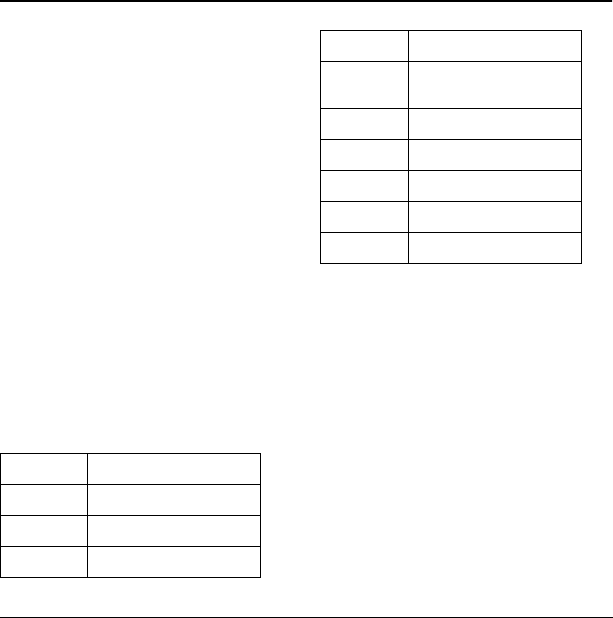
74 Customer support
16 GETTING HELP
Customer support
Your service provider’s customer support
department may be accessible directly from your
phone when you dial a number, such as *611
(check with your service provider). They can
answer questions about your phone, phone bill,
call coverage area, and specific features available
to you, such as call forwarding or voicemail.
For questions about the phone features, refer to
the materials provided with your phone, or visit
www.kyocera-wireless.com.
For additional questions, you may contact the
Kyocera Wireless Corp. Customer Care Center in
any of the following ways:
•Web site: www.kyocera-wireless.com.
•Email: phone-help@kyocera-wireless.com.
•Phone: 1-800-349-4478 (U.S. and Canada) or
1-858-882-1401.
•Customer support phone numbers are also
available in the following countries:
Before requesting support, please try to
reproduce and isolate the problem. When you
contact the Customer Care Center, be ready to
provide the following information:
•The name of your service provider.
•The actual error message or problem you are
experiencing.
•The steps you took to reproduce the problem.
•The phone’s mobile equipment identifier
(MEID).
Note: To locate the MEID select Menu > Settings
> My Phone > Phone Info > Build Info and
scroll down to MEID: for the 11-digit number. If
your phone uses an electronic service number
(ESN), then ESN: will replace MEID:.
Argentina: 0-800-666-0052
Australia: 1-800-507-000
Brazil: 0-800-55-2362
Chile: 800-43-1212
Colombia: 01-800-700-1546
India: Toll fee#: 1-600-121214
Toll#: 0124-284-5000
Mexico: 001-866-650-5103
New Zealand: 0-800-990-100
Panama: 001-800-51-934
Puerto Rico: 1-866-664-6443
Venezuela 0-800-100-2640

User Guide 75
Qualified Service
If the problem with your phone persists, return
the phone with all accessories and packaging to
the dealer for qualified service.
Phone accessories
To shop for phone accessories, visit
www.kyocera-wireless.com/store. You may also
call us at 800-349-4188 (U.S.A. only) or
858-882-1410.
Become a product evaluator
To participate in the testing and evaluation of
Kyocera Wireless Corp. products, including
cellular or PCS phones, visit beta.kyocera-
wireless.com.

76 Become a product evaluator

User Guide 77
INDEX
Numerics
1-touch dialing, 49
A
accessories
headsets, 56
memory card, 56
phone, 75
power backlighting, 56
settings, 56
T-coil hearing aid, 57
TTY device, 57
activating Bluetooth, 42
adding
Bluetooth devices, 43
codes, 21
contacts, 20
extensions, 21
voice dial list, 50, 71
airplane mode, 48
set date/time, 48
alarm clock, 60
alertsbrowser, 54, 65
do not disturb, 69
messages, 39, 46
minute, 50
missed calls, 46
pages, 39, 46
privacy, 52
roaming calls, 54
roaming service, 53
vibrating, 45
voicemail, 39, 46
answering calls, 10
appended messages, 37
applications
details, 67
disabling, 67
downloading, 66
opening, 66
removing, 67
auto redialing, 49
auto retrieve, 35, 40
auto-erase, 40
auto-hyphenation, 49
B
back key, 9
backlighting
power, 56
settings, 47
banner, 47
battery
caring, 1
charging, 1
installing, 1
recharging, 1
Bluetooth, 42
adding devices, 43
connecting, 43
disconnecting, 44
pairing, 43
phone name, 44
settings, 44
turning on, 42
bookmarks, 65
BREW, 66
brightness, 48
browser, 64
alerts, 54, 65
launching, 64
options, 64
searching, 65
business ringers, 44
C
calculator, 61
calendar, See scheduler
call history, See recent calls
call lists
erasing, 19
viewing, 18
call logs, see recent calls
call timers, 19
callback number, 40
text message, 33
callers IDs, 29
calls answering, 10
call lists, 18
data, 52
emergency, 13
ending, 11
fax, 52
holding, 49
limiting, 55
making, 10
roaming, 13
silencing, 12
voice commands, 72
camera, 26
brightness, 27, 28
color tone, 27

78
flash, 26
indicators and icons, 28
last picture, 27
last video, 28
LED indicator, 27, 28
mode, 26, 28
multishots, 27
picture compression, 27
picture settings, 26
recording light, 28
recording sound, 28
recording videos, 27
resolution, 26
save location, 27, 28
self timer, 26
shutter sound, 27
taking pictures, 26
video compression, 28
white balance, 27, 28
capitalization, 16
car kits, 73
CDMA privacy, 52
changing modes, text entry, 16
colorthemes, 46
tone, 27
com port speed, 56
connecting Bluetooth devices, 43
connection type, 53
contacts, 20
adding, 20
adding to a group, 22
assign number type, 24
assign picture, 21, 24
assign ringer, 21, 23
calling numbers, 22
customizing, 21
directory, 20
editing, 20, 21
email addresses, 22
erase, 21
erasing, 20, 22, 55
fast find, 50
frequent list, 50
groups, 24
memory, 25
notes, 23
primary number, 22
searching, 25
secret, 22, 23
send as vCard, 20, 21, 24
sending mulitmedia message,
22
sending text message, 22
speed dial list, 22
street addresses, 23
viewing all, 20
voice search, 72
voice tags, 21
web addresses, 22
convenience settings, 48
conventions, using this guide, 9
countdown timer, 62
creating
groups, 25
playlists, 69
custom menu, 11
customer support, 74
customizing contacts, 21
D
data calls, 52
setup, 53
default text mode, changing, 40
dialing
1-touch, 49
auto redial, 49
speed, 12
voice list, 71
directory, contacts, 20
disconnecting, devices, 44
display
backlighting, 47
banner, 47
brightness, 48
color themes, 46
language, 48
main menu, 47
screensavers, 46
settings, 46
ticker, 47
time/date format, 48
wallpapers, 46
download applications, 66
downloading
applications, 66
games, 66
drafts folder, 38
E
earpiece, 10
volume, 45
editing contacts, 21
email addresses, 22
emergency
calls, 13
numbers, 55
end key, 9
entering
letters, 15
numbers, 15
smileys, 16
symbols, 16
text, 17
equalizer, 69
erasing
contacts, 55
multimedia messages, 37
text messages, 37
evaluation, product, 75
F
fast find, 50
faxes, 52
flash, 26
flip answering calls, 50
sounds, 45
folders
camera pictures, 27, 29
draft, 38
images, 29
inbox, 33, 36
media gallery, 29
outbox, 38
sent, 38
sounds, 30
video album, 28
videos, 30
frames, 27, 29
frequent list, 50
G
gallery, media, 29
games, 58
downloading, 66
groups, 24
assign picture, 25
assign ringer, 25
creating, 24, 25
erase, 25
sending mulitmedia message,
25
sending text message, 25
H
hands-free, 73
auto answer, 56
voice answer, 51
voice wake-up, 51
headsets
auto answer, 56
sounds, 56
help, getting, 74
hold calls, 49
I
icons, 6, 52
camera, 28
multimedia messages, 36
text message, 33
images
browsing, 29
saved, 29
inbox, 33, 36
incoming calls, 18
indicators, camera, 28
Internet, 64
K
keypad
key tone length, 46
sounds, 46
volume, 45
keys frequently used, 5, 8
music player, 68
tone length, 46
tones, 46
L
language, 48
left softkey, 8
lights only alerts, 45
limiting calls, 55
location information, 54
lock code, 55
locking
phone, 54
text messages, 34, 37
low light mode, 26
M
main menu, 8, 47
making calls, 10
media gallery, 29
memopad, 62
memory, 67
memory card, 56
installing, 3
removing, 3
menus
custom, 11
main, 8
main view, 47
settings, 42
messages
alerts, 39, 46
appended, 37
auto-erase incoming, 40
callback number, 40
completing, 38
default text mode, 40
failed, 38
incoming calls, 38

80
multimedia messages, 34
pending, 38
quicktext, 39
saved, 38, 40
settings, 39
signature, 39
text messages, 32
unable to send, 37
minute alerts, 50
missed calls, 18
alerts, 46
deal with, 18
modes
airplane, 48
camera, 28
expert, voice, 50
ringers, 45
text entry, 15
video, 27, 28
modifying playlists, 70
multimedia messages
auto retrieve, 35, 40
CC/BCC fields, 40
creating, 34
erasing, 37
forwarding, 36
icon, 36
notifications, 35
options, 35
previewing, 35
prompts, 36
quicktext, 35
recording sounds, 35
recording videos, 35
replaying, 36
replying, 36
request receipt, 35
retrieving, 35
saving, 37
send later, 35
sender information, 36
set priority, 35
slides, 37
taking pictures, 34
viewing, 36
multiple pictures, 27
music files
browsing, 30
loading, 69
music library, 68
music player, 68
auto filtration, 69
auto off, 69
Bluetooth, 69
keys, 68
loading songs, 69
minimizing, 68
options, 68
repeat, 68
shuffle, 69
visual effects, 69
N
navigation
basic, 8
key, 8
shortcuts, 8
network
data setup, 53
location information, 54
set phone line, 53
user name, 53
network settings, 52
notes, contacts, 23
notifications
multimedia messages, 35
text messages, 33
O
ok key, 9
open to answer, 50
outbox, 38
outgoing calls, 18
P
page alerts, 46
pages alerts, 39
pairing, 43
personal ringers, 44
phone
accessories, 75
answering calls, 10
Bluetooth name, 44
codes, 21
extensions, 21
icons, 6
keys, 8
making calls, 10
overview, 3
setting line, 53
turning on and off, 10
phone information, 52
icons, 52
software build, 52
picture messages, see multimedia
messages
pictures
assigning, 29
compression, 27
erasing, 29
frames, 27
last taken, 27

User Guide 81
locking, 30
modifying, 29
saved, 29
taking, 11, 26
playback tools, 31
playing songs, 68
playlists, 69
accessing, 69
creating, 69
modifying, 70
repeat, 68
shuffle, 69
power
backlighting, 56
on and off sounds, 45
prepend, 22
primary number, 22
privacy alerts, 52
product evaluator, 75
prompt mode, 36
Q
qualified service, 75
quick alarm, 61
quicktext, 39
R
rapid entry, 16
receipt request
multimedia messages, 35, 40
text message, 33
text messages, 40
recent calls, 18
redialing, 10
repeating tracks, 68
replying
multimedia messages, 36
text messages, 33
resolution, 26
restrict roaming, 53
right softkey, 8
ringers, 30, 44
business, 44
mode, 44
personal, 44
roam, 44
silent mode, 45
type, 44
volume, 45
roaming
call alerts, 54
restrict, 53
service alerts, 53
S
scheduler, 58
creating events, 58
modifying events, 60
settings, 60
viewing events, 59
screensavers, 29, 46
searching
contacts directory, 25
fast find, 50
frequent list, 50
voice commands, 72
world clock, 63
security
emergency numbers, 55
erasing contacts, 55
limiting calls, 55
lock code, 55
locking phone, 54
settings, 54
self timer, 26
sent folder, 38, 40
set priority
multimedia messages, 35
text message, 33
setting
alarm clock, 60
quick alarm, 61
world clock, 63
setting date and time, 48
settings
accessories, 56
alerts, 46
Bluetooth, 44
camera, 26, 28
convenience, 48
display, 46
menu, 42
messages, 39
music player, 68
network, 52
phone information, 52
picture, 26
scheduler, 60
security, 54
sounds, 44
USB mode, 57
video, 28
voice commands, 50, 73
shortcuts
navigation key, 8
shutter sound, 27
signature, 39
silent mode, 45
smart sound, 45
smileys, 16
software
build information, 52

82
songsloading, 69
playing, 68
repeating, 68
sounds
assigning, 30
browsing, 30
erasing, 30
flip closed, 45
flip open, 45
keypad, 45
locking, 30
playback tools, 31
playing, 30
power on and off, 45
ringers, 44
saved, 30
settings, 44
silence all, 45
volume, 45
speakerphone, 11, 12
volume, 45
speedcom port, 56
dialing, 12
stopwatch, 62
support, customer, 74
symbols, 16
T
T-coil hearing aid, 57
teletype, 57
text entry, 15
capitalization, 16
changing modes, 16
current mode, 15
default mode, 40
letters, 15
numbers, 15
quick reference, 17
rapid entry, 16
text messages
callback number, 33
creating, 32
enhanced options, 32, 34
erasing, 37
forwarding, 34
icon, 33
locking, 34, 37
notification, 33
options, 33
quicktext, 32
replying, 33
request receipt, 33, 40
retrieving, 33
saving, 34
send later, 33
sender information, 34
set priority, 33
validity period, 33
viewing, 33
ticker, 47
time calls, 50
timer, 62
tip calculator, 61
tools, 58
alarm clock, 60
calculator, 61
memopad, 62
scheduler, 58
stopwatch, 62
timer, 62
tip calculator, 61
voice memo, 58
world clock, 62
TTY device, 57
turning on and off, 10
U
USB, 57
user name, 53
V
validity period
text message, 33
vibrating call alerts, 45
video mode, 27, 28
videos, 30
album, 30
compression, 28
erasing, 31
last taken, 28
locking, 31
playback tools, 31
playing, 31
recording, 27
recording light, 28
recording sound, 28
saved, 30
sending, 31
viewing contacts, 20
voiceanswer, 51
dial list, 71
memos, 30
privacy, 53
training, 52
wake-up, 51
voice commands, 71
calling contacts, 72
calling numbers, 72
display results, 51

User Guide 83
expert mode, 50
find contacts, 72
play, 72
settings, 50
shortcuts, 72
training, 52
voice dialing
activating, 11
adding contacts, 71
automated lists, 50
digit lengths, 51
removing contacts, 71
voice memos, 58
erasing, 58
locking, 58
playing, 58
recording, 58
voicemail, 12
alerts, 39, 46
number, 41
volume, 45
adjusting, 12
earpiece, 45
keypad, 45
ringers, 45
smart sound, 45
speakerphone, 45
W
wallpapers, 29, 46
web addresses, 22
alerts, 54
browser, 64
web addresses, contacts, 23
white balance, 27, 28
world clock, 63
searching, 63

84

User Guide 85
Kyocera Wireless Corp.
10300 Campus Point Drive
San Diego, CA 92121 USA
www.kyocera-wireless.com
82-G1887-1EN, Rev. Draft 0.7

86